The post Lost in Bosnia appeared first on The Expeditioner Travel Site.
]]>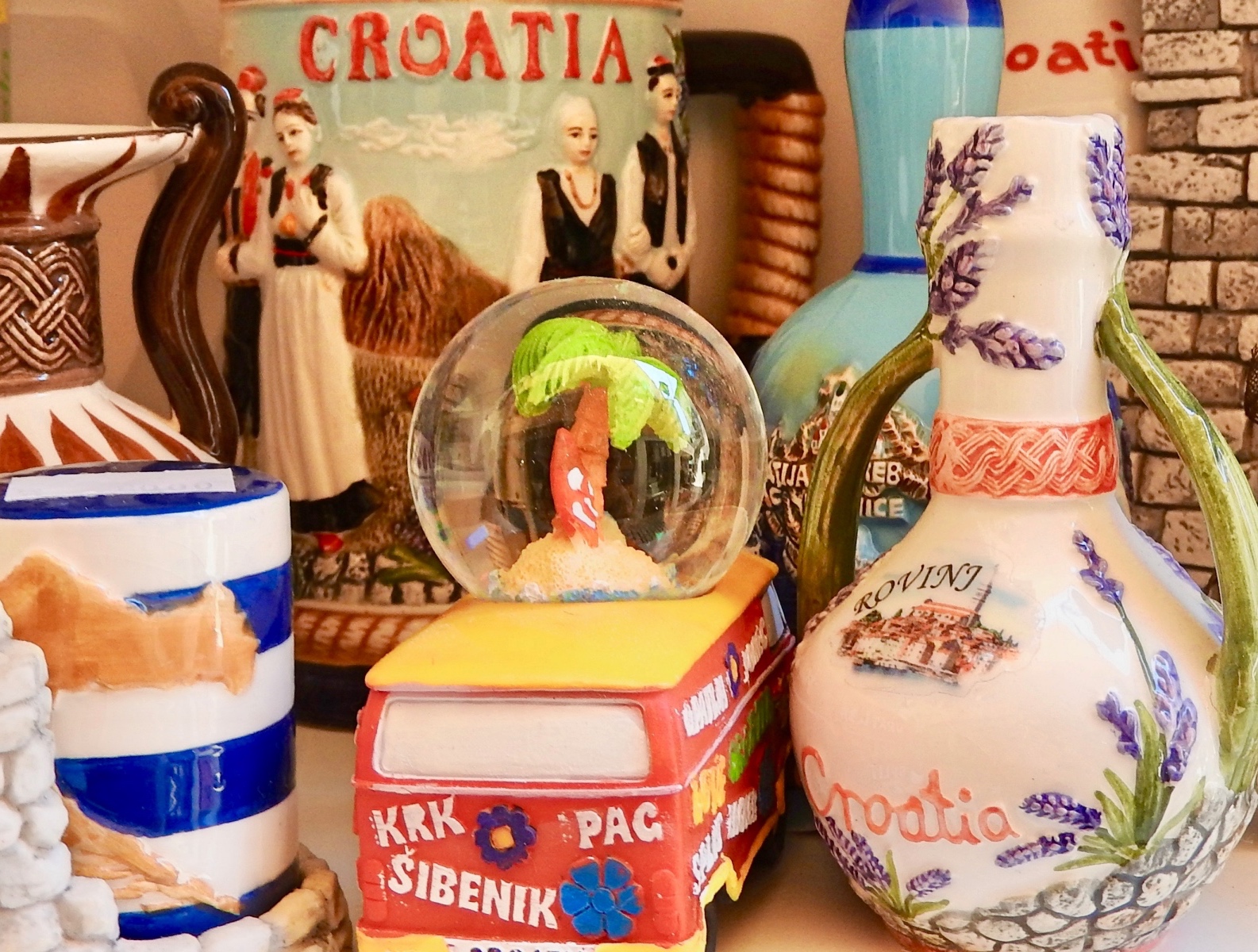
A friend once said to me, “You’ve traveled so much, I bet you don’t even know how many countries you’ve visited.” I shrugged and pretended she was right. But I knew. I knew exactly.
As I suspect is the case with many other compulsive tourists, I keep a list of the countries I’ve entered. I started counting in 1968, when I left the U.S for the first time as a Peace Corp volunteer to Kenya, and of the 193 nations with seats in the UN, I have visited 50. The number isn’t extraordinary, but it pleases me. Or at least it used to. It cost me many days of jet-lagged, foggy-headed, new-city wandering, and I have always insisted to myself that my travels have broadened my sense of the world. But since my errant visit to Bosnia, I’m no longer sure that’s true.
I keep my list of countries high on a closet shelf folded into my copy of Patricia Schultz’s fat compendium, One Thousand Places to See before You Die. (I’m at 214.) With it is a passport that expired in 2010, a document recording my travels to so many countries that I had to return it to the State Department in 2007 to have additional leaves attached. Each page is covered with stamps or stickers or stapled visas, and I recall my self-satisfaction whenever I stood before a frustrated customs officer who thumbed through page after page, looking for a place to add one more rubber stamp to the array of destinations already before him. That iconic blue American passport doesn’t define me, I told myself. I am so much more than an American; I am an international traveler, a global adventurer, an economy-class Odysseus. I am a Citizen of the World.
But there’s a question I’m now asking myself: What exactly constitutes visiting a new country? When can I add to the list? Do I count my trip to Tahiti in French Polynesia? An exotic destination for sure, but by international law I was visiting France, and since it is located exactly 12 time zones from Paris, the French don’t even reset their wristwatches when they arrive. And there’s also my obsessive visa-collecting behavior when I walked the bridge over the Zambezi River leaving Zimbabwe and entering Zambia for no other reason than to have my passport stamped. I remember a vertiginous view of Victoria Falls and an unpredictable return trip in a rusty Datsun taxi with an engine that only came to life when the driver joined two wires that hung from the dashboard, but have I really visited Zambia?
I have one traveler friend, an ever-contentious guy, who seems perpetually dressed in comfy, long-flight sweats and shoes easily slipped off for TSA scanners. I always imagine him with one hand grasping a carry-on spinner-bag. He once asked me straight out, “Tell me, how many countries have you been to?”
I was shocked by his blunt curiosity. Important as it is to me, my list is my secret, a private matter, like my salary or my weight. How could a fellow Citizen of the World pose such a crude question? How could he display such a lack of sophistication? But I answered him with whatever my number was at the time.
“62,” he replied with a raised eyebrow. “Gotcha beat!”
“Wow, that’s great,” I said with no conviction. Then, like a righteous fifth-grader confronting a bully on the playground, I challenged him. “How do you count them?” I said. “Legal entries, right? Passport stamps.”
He looked annoyed, ignored my question and started a long tale about a rude customs officer on a recent trip to Nepal. Clearly he’d been padding his count. He was a cheater who included every place a plane he’d flown had touched down.
I remembered my brief sojourn in Reykjavik, Iceland, where a charter flight in the 1970s landed to refuel. I would never consider including Iceland on my list. Clearly, I was superior to this crude braggart. But what about Vatican City? I’ve seen the complacent angels on the Sistine Ceiling and the Laocoön’s struggle against divine power, but does a 100-acre religious enclave really count as a country? And Monaco. I definitely saw an exit for the principality as I cruised the autostrada between Genoa and Nice, but did I cross its border? I’m not sure whether I should add it to my list or not.
The conversation with my hoaxer-friend made me realize that I needed some standards. I pondered this issue for months and decided on two requirements to have visited a country: First, I needed a legal entry and second, I had to have a witty or adventurous story to take home to admiring friends. So Bolivia, where a wandering flight itinerary took me south from Peru before I flew back to Miami, doesn’t count. Legal entry, but no story. And Tanzania doesn’t count. My oddly nationalistic Kenyan guide had walked me to an invisible line in Maasai Mara Game Park and invited me to pee into neighboring Tanzania. I crossed into Tanzania and peed back into Kenya. So I had a story, but no legal entry.
So I’ve given my list a lot of thought, and I’ve created standards. But not long ago I took a trip to what was once Yugoslavia and got lost in Bosnia. Since then I’ve stopped counting.
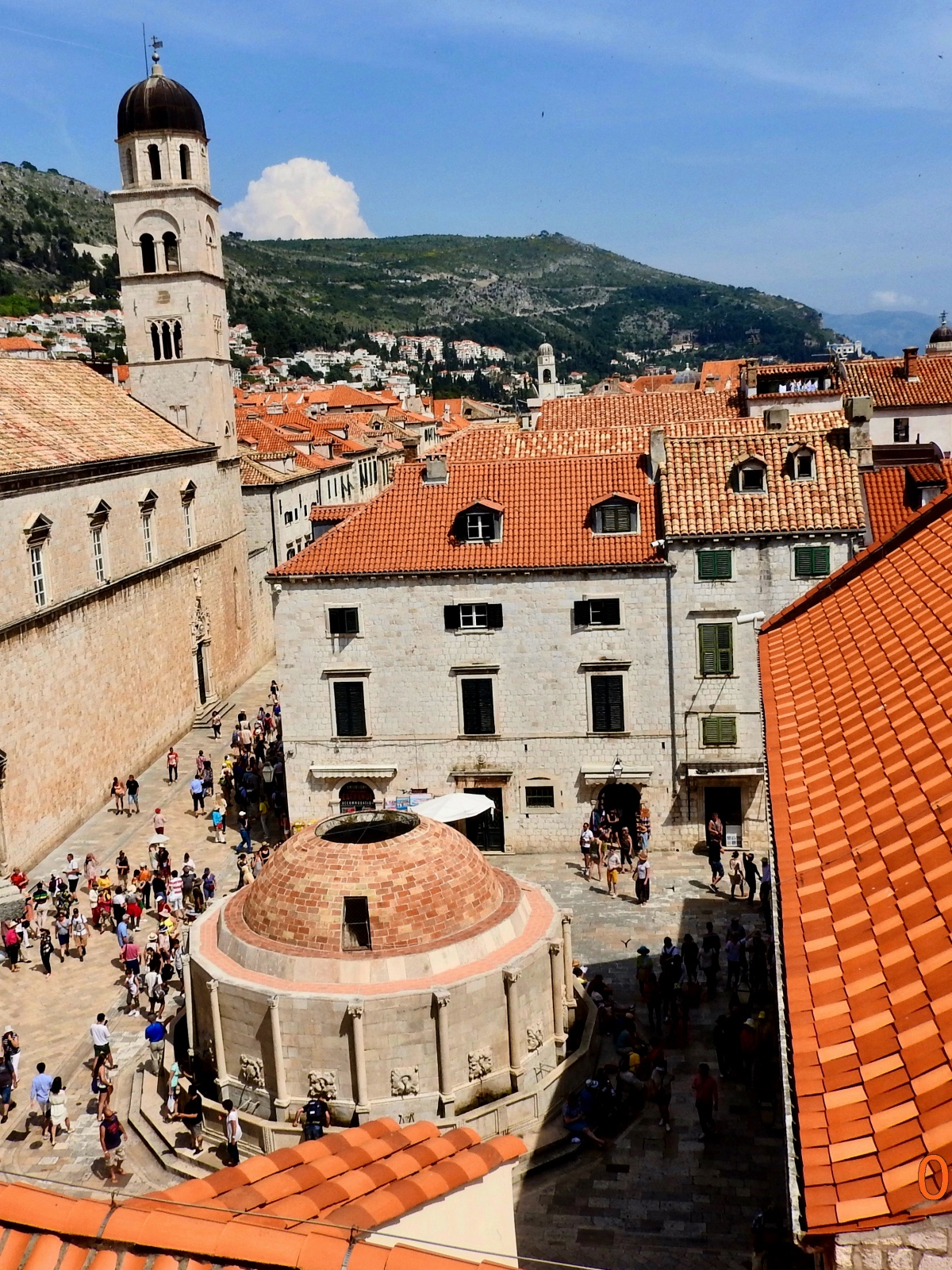
My journey started simply enough with a drive from Split to Dubrovnik, both in Croatia. My yellow Suzuki Swift rental was living up to its name, and my recurring American anxiety about a stick-shift had faded in the soothing sunshine. I whizzed across an autocesta so smooth and so traffic-free that U.S. interstates should crumble with envy. I was at the top of my tourist game with no fussy tour-bus co-travelers and no annoying guide to direct my interest or redirect my impulsive sightseeing inclinations. I was making good time, and the prospect of Dubrovnik, an Adriatic tourist mecca, lay before me.
The route? No problem, I thought. My iPhone was mounted on the dash and the imperturbable Siri, with her mellifluous voice and her GPS certainty, assured me of the shortest, speediest route. I would just adhere to her unobtrusive urgings and follow the familiar blue line that I knew led straight to Dubrovnik and the comfortable apartment I’d reserved behind the city’s ancient walls.
My mood was so euphoric that my mind drifted. I’m not sure whether it was thoughts of a tasty dinner or Diana Krall’s seductive American voice from the CD player, but I completely missed Siri’s faithful reminder that my exit was approaching in two kilometers. I also missed her warning of the exit in 500 meters and her final exhortation to take the next off-ramp. I zoomed happily forward, anticipating and indulgent evening downing fresh Dalmatian lobster and sipping slivovitz.
After a few moments, I wondered if perhaps I’d missed my exit. Never mind, Siri would reroute me.
The tires hummed on the even pavement, but now the highway signs acquired odd, unexpected names: Čapljina and Stolac and Trebinje. What happened to Dubrovnik? Where was Siri taking me?
I touched the “repeat direction” icon, but she didn’t respond. I tapped a second and third time, and it dawned on me that Siri’s faithful voice had failed me. She was gone. There were no more directions, not a word of guidance. A moment later, Siri’s ever-dependable map vanished from my screen. Exits, roads and town names all evaporated, replaced by a vacant grid. According to my muted iPhone, I was driving across a vast sheet of beige graph paper on a lonely blue line that directed me mysteriously forward.
I recalled the cautious internet search I made before leaving home. Yes, I had assured myself, Croatia would supply Siri’s turn-by-turn navigation. Wherever I went, she would show the way. But then I had a darker thought: Perhaps I was no longer in Croatia. How close to the border had I been? I tried to recall my mental map of what was once Yugoslavia. I knew Croatia was the old country’s shoreline, the area that was a haven for tourists from all over Europe. And just inland, I remembered, was Bosnia. The name made me shiver.
For the first time ever, I didn’t know what country I was in. I was a world traveler, a counter of countries, a Citizen of the World, and I was lost. Tourist-friendly Croatia had vanished. I grew suddenly nostalgic for what I had seen the previous days: Roman ruins, ancient cathedrals and most of all, the inviting and vibrant blue of the Adriatic.
As I drove, the terrain changed, or perhaps I imagined it changed. The scenery looked sparse, arid. Green turned brown and plants appeared to struggle in the heat. Life seemed to have given up in this place, yet there was a kind of mournful and austere beauty to it.
Five minutes. Ten. Fifteen. Two lanes in each direction, a rocky median strip, and no way to turn around. The blue line on the iPhone grid pointed through the barren landscape outside my windshield.
Finally in the distance, I saw a gray structure spanning the highway. I approached, and it became a border crossing, an imposing mountain of concrete and steel designed to intimidate tourists, smugglers and perhaps invading armies. I pulled cautiously into one of its gates and looked up at a swarthy man with a gaunt, no-nonsense face and a crisp uniform who spoke a word he expected to be universally understood.
“Pasoš!”
I dug through my pockets and handed over my blue passport. Surely, I thought, he’ll be impressed when he sees how many places I’ve visited. He’ll welcome a cosmopolitan sophisticate like me to his homeland.
“Where am I?” I asked hopefully.
He twisted his mouth and pointed at a slack flag on a pole just ahead. It looked familiar, but I wasn’t sure: Bosnia? Croatia? Montenegro? I made out some stars, a blue background and a yellow triangle. I was pretty sure the Croatian flag was mostly red and white. The man gave my passport a firmly officious stamp and handed it back. The look on his face said he was through with me. Time to move on. I made a final try for help.
“Dubrovnik?” I said.
He held up four fingers, all the reply he was willing to give, then used the same four fingers to wave me away. I stepped on the accelerator.
Four kilometers? Four hours? The fourth exit? Who knew? The last glimmer of information from Siri had been that I was two hours from Dubrovnik.
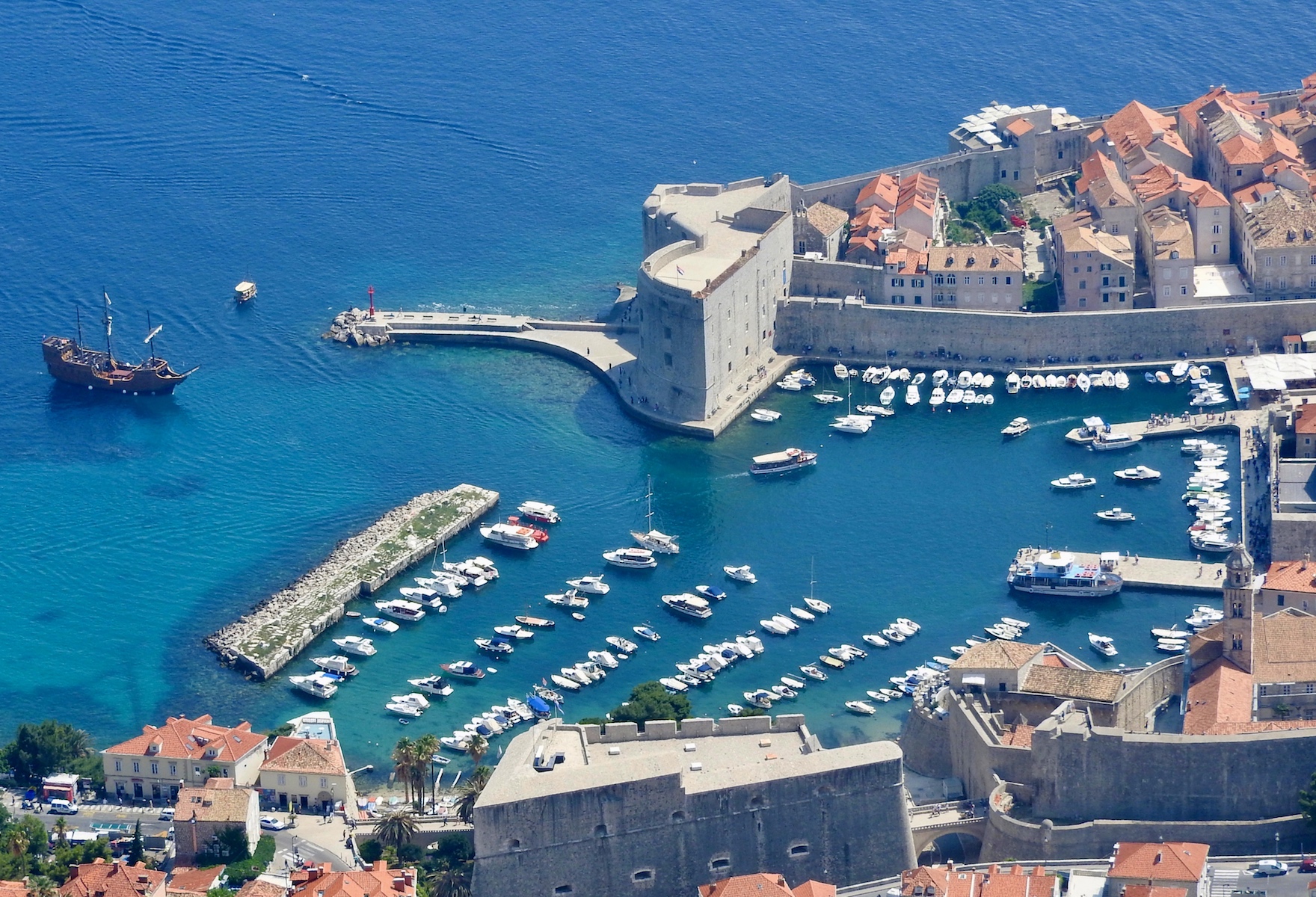
I sped along, becoming more convinced that I was in Bosnia. What I knew of the country was what I recalled of the war in the 1990s. I scoured my brain. The Yugoslavian breakup created several new countries, but how many? What were they? And why had I ignored the history chapter at the back of my Lonely Planet guide? It had been over 20 years since the war, and all I recalled were horror stories about Serbian Christians, Muslim Bosnians, smashed countries and a bloodbath that was in the news for months — maybe years.
I remembered a Serbian general, ”The Butcher of Bosnia,” a war criminal responsible for the deaths of thousands. In Croatia, the grim past was obscured in a lucrative vacation paradise of quaint cities and a glorious coastline. Not so with Bosnia. From some dark corner of my brain came the memory of a play called Blasted by an English playwright whose name I’d forgotten. It was the most unsettling evening I’d ever spent in the theater: two hours of characters haunted by the violence and depravity of the war where Yugoslavia had been. They played out their atrocities and nightmares: rape, blood, murder and worse. Now I was where it all happened.
I followed my iPhone’s blue line across its beige grid, then suddenly it directed me to an exit. I had no real choice. Beyond the off-ramp, the broad even highway ended. I was on a two-lane road that became narrower as the kilometers passed. The blue line swerved to match the route I saw ahead but provided no further help. I climbed hills and threaded through curve after curve. A dark forest surrounded me then loomed above me. The sound of my tires on the tarmac rumbled unevenly as my little yellow Suzuki bounced and shook on pavement that alternated between wheel-grabbing ruts and bone-jarring potholes.
As I rounded a turn, a shabby building with peeling brown paint appeared at the edge of the forest. My path narrowed to a single lane and a gate swung down to block my way. The knot in my stomach made me imagine the worst. Was it some kind of ambush? An attack by unreconstructed soldiers who hadn’t given up their war? A shadowy figure in a uniform that looked official but not particularly military emerged from the building. His tan outfit was wrinkled, but he was well fed with a gut that swelled over his belt.
Another border crossing? My speculation seemed confirmed as I stopped and the man extended an open palm, so I handed over my passport. He gave the document a perfunctory glance, a quick stamp and handed it back.
I sighed with relief and pointed ahead. “Dubrovnik?” I asked.
“Ravno. Ravno naprijed. Jedan ili dva sata,” he said pointing straight ahead grinning with a row of tobacco-yellowed teeth.
“Okay,” I said, “sounds good.” And I was on my way.
The dark forest brightened, and I relaxed as the road widened and grew smoother. Then Siri’s comforting voice descended from heaven.
“Merge left onto Highway E65 ahead.”
I did as I was told, and a glorious roadmap of Croatia materialized on the screen of my iPhone. It was all there: my road, the roads that crossed it, happy towns and finally the joyful information I’d longed to see:
Distance to Dubrovnik: 97 Kilometers.
Time to arrival: One hour and 34 minutes.
My heart leaped. I was safe. I was back in Croatia. I had emerged unscathed from my imaginings of a war-torn wasteland and passed from fear into safety, from darkness into light. I cruised rapturously onward, my Suzuki humming effortlessly along the flawless pavement, and within a few kilometers, the Adriatic gleamed to the right of the roadway. Once again, I was a global traveler, a stalwart World Citizen boldly (but safely) seeking adventure (and dinner).
Within a couple of hours, I’d bid my rental Suzuki farewell, passed through the gate in Dubrovnik’s massive old walls and joined a frenzied crush of European and Asian tourists. The apartment I had reserved, with its wide bed and conditioned air, was tourist nirvana. I collapsed into a long nap before dinner.
***
That evening I sat in a restaurant that my Michelin Guide recommended as a good bet for dinner. Before me on a wide dish was the Genghis Khan plate: a heap of grilled rump steak, turkey, and chicken, that included sausage and minced meat with names that I couldn’t pronounce and spicy aromas that I couldn’t resist. I’d been sipping on a crisp pilsner with a name that intrigued me: Sarajevsko. Sounds like Sarajevo, I thought; that’s the capital of Bosnia, where I’d had my afternoon escapade. The name of the restaurant roused my curiosity, too, so I asked the server about it. He was a bright, amiable young guy, probably 25, who seemed willing to charm an older diner in hopes of a good tip.
“Why is this place called Taj Mahal?” I said.
“You know the Taj Mahal?” he replied in near-perfect English I expected in a tourist town. “In Agra? In India? It’s the most beautiful building in the Muslim world, maybe the whole world.”
I remembered. When I had stood before the building years earlier, the dawn light tinted its marble walls to a miraculous shade of rose. The rumble of the tourist crowd and the prattle of nearby guides went away, and I was speechless.
“Well,” my server continued, “we are Bosnian Muslims. We want our restaurant to be the best in the world, so we named it Taj Mahal.”
“You’re saying the best place to eat in Dubrovnik, Croatia, is a Bosnian Muslim restaurant?”
“Of course.”
“Of course,” I agreed. “Now, would you say your desserts are the best in the world?” He smiled and handed me a menu.
Waiting for my baklava and an espresso, I pulled out my passport and thumbed through the pages until two smudged stamps, each obliterating a presidential face on Mount Rushmore, documented that I had actually entered Bosnia and returned to Croatia. With a legal entry and a tale to tell when I got home, I’d met my criteria for adding one more country to my life list. Country number 50, I thought. Half a hundred. What should have felt like a tourist milestone somehow didn’t.
My espresso arrived and I took a sip. In a few days I’d be home. One of my travel rituals is to come up with a quick answer for the inevitable question: “How was your trip?” Usually the answer is easy. “Oh, Chile was amazing,” I’d say condescendingly, “Alpine mountains and that vast rocky desert.” Or: “Cambodia was astonishing. Angkor Wat and the unbelievable green of those jungles.” Or: “Croatia was sensational. The Adriatic and those ancient Roman ruins.” I touted every trip as amazing or astonishing or sensational. But that kind of glib response was wrong for Bosnia.
I had a story and two blurry stamps on my passport, but while I was there, I thought only of getting out. All I wanted was Siri’s reassuring voice. I’d been lost and scared, and for no real reason. What had I missed? I knew that terrible things had happened there, but I’d come and gone without even touching the ground. My single-sentence summary should be something like, “I didn’t have any idea where I was or what I was doing.” I’d seen nothing. Maybe, I thought, I needed to come up with some new travel rituals, something better than country-counting or a reductive catch-phrase.
I looked up, saw my server helping diners at the next table and did some math. He had to have been born during the Bosnian War and grown up in its aftermath. What would today’s drive have been then? I tried to imagine thundering tanks, rocket attacks, concussive explosions, crumbling buildings and shattered lives, but my imagination failed me. I knew nothing about him or his home.
My mind drifted to the first time I’d ever left the United States. After weeks of training, I traveled with a jetload of Peace Corps volunteers to our teaching assignments in Kenya. When we made a stop long after midnight in Entebbe, Uganda, I got off the plane to stretch my legs and wandered away from the cluster of chattering fellow volunteers.
I stood on the tarmac in the middle of an African night, inhaled deeply, and looked up at a strange sky with new constellations and the moon tilted at an odd new angle. Songs of a thousand insects thrummed from the grass beyond the runway. Everything before me — the one-room air terminal, the curve of the palm trees, the warm moist air that enveloped me — was unlike anything I’d seen before. The world was suddenly vaster than I’d known.
Other than the control tower, the air terminal was a single-story wooden building that was bordered by a neat, low hedge. At one end, an open-air bar filled the night with blue-white florescence and Afro-pop jukebox rhythms. I took a seat near a couple of Ugandan men huddled over beers and engaged in a mysterious conversation in an even more mysterious language. Again and again they eyed a nearby woman with an immense purse and a red miniskirt marking her as the first prostitute I’d ever seen. I was a nervous kid from a California suburb sipping a Tusker lager and savoring his first moments on the continent. In the months ahead, Africa would open me to new landscapes, new languages, new cultures and new ways of living. It was exotic and frighteningly exciting, but I embraced it. Unlike my trip to Bosnia, the last thing I wanted to do was leave.
Decades later, sitting in this fancy Dubrovnik restaurant, I understood that all my travels had been failed attempts to recapture that single exhilarating moment at the airport in Entebbe. When I traveled now, the wonder was gone, replaced by zippy rental cars, air-conditioned rooms, guidebook-recommended restaurants and Siri, who prescribed my every move. Plus, of course, there was the mindless arithmetic of country-counting.
When my server brought my baklava, I looked down at the syrupy confection, but I knew its easy sweetness wouldn’t satisfy me. I’d gotten it wrong. My travels had become about visas in a passport. The hotels and guidebooks had obscured the delights of meeting new people, seeing new landscapes, gaping at new architectures and learning exotic histories. How was I different from my friend who padded his country-count to impress others? I felt no different at all, and I was humbled.
It’s time to lose track of how many countries I’ve been to, I thought. Instead, I’ll try to gather moments like the one in the Entebbe airport bar. I’ll avoid my petulant tales about hotel rats in Kathmandu or filthy café toilets in New Delhi. Now I’ll try to come home with stories that I’ll remember because I’ve learned something, not because they impress friends — memories of people and places that amaze or bewilder or maybe scare me a little. I’ll try to slow down, stop obsessing about where I’ve been and pay attention to where I am.
I looked up at my young server and decided to ask him where he went for an after-work drink. I was looking for a place, I’d say, for some conversation with ordinary Croatians. Maybe he could recommend something.

 Paul C. Dalmas is a freelance writer who has made his living as boilermaker’s helper, a fry cook, and a high school English teacher. His work has been broadcast on KQED-FM and published in Newsweek, The San Francisco Chronicle and California Magazine. He lives in Berkeley, California.
Paul C. Dalmas is a freelance writer who has made his living as boilermaker’s helper, a fry cook, and a high school English teacher. His work has been broadcast on KQED-FM and published in Newsweek, The San Francisco Chronicle and California Magazine. He lives in Berkeley, California.
The post Lost in Bosnia appeared first on The Expeditioner Travel Site.
]]>The post Pedaling Around Expat Expectations in Zimbabwe appeared first on The Expeditioner Travel Site.
]]>
Vehicles with drivers seeking an early start to the weekend jammed the intersection. I gingerly approached the mayhem, weaved through traffic and took a sharp, two-wheeled left onto the sidewalk. I left the bottleneck behind; however, I still can’t steer clear of criticism for not owning a car in Zimbabwe, an apparent affront to the social order.
After accepting my first teaching assignment in Africa in 2016, I received an email from the school, outlining some of the necessities: lightweight clothing, generous amounts of sunscreen and above all, a car, preferably an air-conditioned SUV.
I wasn’t surprised a vehicle topped the list because I was moving to Harare, a metropolitan city of 1.6 million people with a five-month rainy season. I understood why parents with children might require a car, but as a bachelor, I didn’t consider it essential. I wouldn’t conform. I’d buy a bicycle instead.
My rationale was simple. With the unemployment rate in Zimbabwe hovering around 90 percent, it’s safe to say most people don’t own a car or ever will. The public transportation system — consisting mainly of mini-vans — is overcrowded, unreliable and some say, unsafe, but it exists. Bicycles are readily available and of course, there’s always walking. If everyone else managed, I could too.
Using a bicycle as my sole mode of transportation has proven to be easier than I imagined. My commute takes 10 minutes. A trip to the nearest grocery store is just down the block, a chore facilitated by a rack enabling me to haul all my purchases. I’m able to hit most of the social spots, although I do rely on friends for lifts to distant destinations.
Considering the country’s long history of fuel shortages, I anticipated praise as I peddled down the road less traveled on my zero-emissions vehicle but it’s been quite the opposite.
“What will you do during the rainy season?”
My customary response: “Get wet.”
Riding through downpours isn’t my idea of paradise but nylon rain gear keeps me mostly dry, an option economically inaccessible for a lot of African cyclists.
“You won’t be able to see many places in Zimbabwe without driving a car.”
True, I lose the ability to drive to any game reserve I want, when I want, but there are buses — even luxury buses — crisscrossing the country, and friends have invited me on out-of-town excursions.
I suspect there’s a deeper, underlying cause for the negativity: expats are expected to buy cars. Though Zimbabwe gained its independence in 1980, the country remains largely segregated racially and economically, clinging to strictly defined norms of behavior for each social strata. Domestic workers walk or, if they’re lucky enough to afford them, ride bicycles. Members of the middle and upper classes, including expats, drive cars.
There are unspoken racial assumptions as well.
During my first week in Harare, I was walking home from school when an elderly, white Zimbabwean woman stopped unexpectedly and offered me a ride. The next day I mentioned it to a black Zimbabwean colleague, saying the gesture was quite thoughtful. “You don’t understand,” she replied, “White people (less than one percent of the population) don’t walk in Zimbabwe,” insisting I was only picked up because of my skin color and the driver’s conclusion something must be wrong.
The societal script even dictates the type of bicycle a person of my status should own. When shopping for my new ride, the salesman kept pointing me in the direction of a $1,500 racing bike and a $700 mountain bike, but I had my eye on a basic, $200 street bike, manufactured with a durable and steel frame, puncture-resistant tires, fenders to minimize the impact of puddles and a rack supporting up to 220 pounds and a small black bell.
Finally, the salesman pulled me aside and, seemingly to spare me the embarrassment of other customers hearing, whispered to me, “You don’t want that bike. It’s for domestics.”
Sold! I figured anyone on the lower rung of the economic ladder in a country with a per capita GDP of about $1,000 would know which vehicles to purchase that last.
I realize I’m unintentionally challenging the status quo, which I believe is the main reason colleagues continue asking when I plan to buy a car.
Cars reinforce the gulf between rich and poor, creating instant autonomy, and thus, isolation. How can a driver get to know those around him if he’s whizzing by with the windows rolled up and the radio blaring? Worse, a car removes expats from the daily reality of most Zimbabweans.

I’m not so naive as to think that by riding a bicycle — as an American working temporarily in Africa — I can even remotely connect with or understand the life of someone surviving on two or three dollars a day. At the very least, I’m able to interact with those in my environment and hopefully dispel the stereotype of the expat who rarely leaves his gated, walled and residential compound, except to drive to his fortified place of business and a few upscale, specialty shops.
I’ve also learned I can easily function without an automobile.
As Westerners, we’re conditioned to the idea that owning a car is as indispensable as the food we eat. Public transportation is out of the question. Alternative transportation, such as a bicycle or a scooter, is impractical. Yet, most of humanity will never get behind the wheel of a car. Most of humanity is inconvenienced. Somehow, individuals carry on.
However, I’ll admit I’ve faced challenges as I limit myself to two wheels. As a developing country, some of Zimbabwe’s potholes are large enough to swallow buses. My bones ache when I think of the number of times I’ve struck one, especially after dark on the plethora of roads without street lights.
There’s also the danger of drunk drivers. Drinking is a huge part of the culture, but the absence of police at night barely deters alcohol overindulgence. I’m often nervous plodding along at midnight, even if I’m clad in a goofy, bright-red helmet and a pair of rain pants, while my Mary Poppins bike is outfitted with reflectors and two flashing lights.
As for dating, I haven’t met any woman willing to go out to dinner aboard my bike, straddling the rack over the back tire. Potential admirers must possess an open mind, a sense of humor, and an ignition key. So far, just one person fit the bill.
Today, almost two years later, a bicycle is still my only means of transport. Yes, it’s not as handy as a car, but I’ve got thighs that would make Jack LaLanne proud. It’s also hard to describe the satisfaction of admiring the sunrise as I glide through a crisp Harare winter morning and being greeted with a chorus of “Hello” and “How are you, Mark?”, or the smiles of fellow bicyclists and pedestrians as I pedal by, along with the daily sound of laughter emanating from a group of three school children, donning maroon blazers, always rushing to beat the morning bell.
I’ll continue to happily embrace this lifestyle if the trade-off is arriving a few minutes later than my motorist friends and not always fitting in with the expat community.

/
 Mark Dickinson is an international teacher currently working in Zimbabwe. Before beginning his career in the classroom 16 years ago, he worked for almost a decade as both a television and newspaper reporter. Mark has visited more than 60 countries. He’s written for several publications, including the Matador Network, and published a travel memoir Sleeping in the Homes of Strangers: A Month-Long Journey of Trust available on Amazon. You can also read his blog, The Traveling Teacher..
Mark Dickinson is an international teacher currently working in Zimbabwe. Before beginning his career in the classroom 16 years ago, he worked for almost a decade as both a television and newspaper reporter. Mark has visited more than 60 countries. He’s written for several publications, including the Matador Network, and published a travel memoir Sleeping in the Homes of Strangers: A Month-Long Journey of Trust available on Amazon. You can also read his blog, The Traveling Teacher..
The post Pedaling Around Expat Expectations in Zimbabwe appeared first on The Expeditioner Travel Site.
]]>The post What’s So Bad About Falling In Love On The Road? appeared first on The Expeditioner Travel Site.
]]>
“Whatever you do, don’t fall in love.” This is the advice my resident advisor gave me when he found out I was heading to England to study abroad for a semester during my senior year. It has stuck with me ever since, not because I thought it was a good bit of wisdom, but because I found it to be a completely useless and ridiculous thing to tell someone, especially someone with the heart of an adventurer.
Let me tell you why this is a terrible piece of advice.
In my mind, it assumes that falling in love abroad can only end badly: either you have to give up everything back home to be with this person, you return home completely devastated because you had to break up, or maybe you try to make the long-distance thing work for a while but eventually it fails and again you end up heartbroken and miserable.
But as an avid traveler who has loved and lost many times while abroad, I refuse to believe that these are the only options. For one thing, what is so terrible about heartbreak? We’ve all experienced it in some way or another and will experience it again and again throughout our lives. Heartbreak is simply part of being human and you can’t have pleasure and joy without pain and sadness. It is the expectation that something will last forever that leads to so much pain when it inevitably ends.
I have had my heart broken many times for many reasons and as much as it sucks, I know that each experience teaches me something and helps me grow a little more. Every time we enter into a relationship with someone, we are opening ourselves up to the possibility of ending up hurt. This is true no matter who we date or where in the world we live.
Why deny ourselves the fun of falling in love abroad just because we are afraid there is greater potential for heartbreak? If you are lucky enough to fall in love and have your heart broken many times throughout your life, I consider that a luxury and a blessing, not a burden.

I am strongly against the idea that “the one” is out there for each of us: how silly to think that there is only one person on this entire earth with whom we can be in a happy and healthy relationship! I believe each of us has thousands of soulmates strewn across the planet and each time we connect deeply with someone, lover or friend, it is because we have met one of our many soulmates. To me, that is much more uplifting than the idea that I will only be happy if I find the one person out of seven billion who is “meant for me.”
You know that quote, “Better to have loved and lost than never to have loved at all”? I know it seems trite, but it really is spot on. Think back to someone you have loved deeply who is no longer a part of your life, or whose relationship with you has changed. Most of us would agree that even if we could go back in time and stop ourselves from ever meeting that person, we wouldn’t want to because they added to our lives in some way, or were an important part of our story. Maybe we even learned a valuable lesson from that person that has helped us move forward in our other relationships.
When I lived in New Zealand for six months, I had a wonderful but tumultuous relationship with a lovely man I met there during a time when we were both exploring polyamory and dating multiple people. Though it was a difficult relationship that eventually ended, we had so many good conversations and fun adventures together. The intensity of our connection forced us both to step back and consider what it was we wanted in a partner and to explore the question of whether we were really ready for that kind of relationship. Despite it ending after only a few months, we both took a lot away from the experience and I will always be grateful for our time together. Our connection was never meant to last forever.

Which leads to my next question: Why does it have to be heartbreaking to love someone and then say goodbye? Why do we always think that love has to last forever or else it’s a tragedy? Just because a relationship ends does not mean it was a failure or didn’t mean anything. A brief but intense romantic relationship can be just as meaningful as one that lasts 10 years.
Throughout my travels, I have experienced many brief but significant connections, both platonic and romantic, and each one has contributed to my life in a positive way. It is up to each of us to get the most out of our relationships and to figure out what lesson each one has to teach us.
Traveling has a way of opening us up to connections that don’t arise quite as easily when we are in the comfort bubble of our daily routines. When we’re in a foreign country where we don’t know the roads, the customs, or the language, we are forced to ask for help from strangers, to undergo uncomfortable experiences without our best friends by our side, to explore new places with people we barely know.
For me, this is one of the most amazing aspects of travel. The constant flow of new, uncomfortable, and exciting experiences enhances our ability to create deep, meaningful connections with new people that we may not have otherwise formed. Going through these types of experiences together creates unique bonds between people that often couldn’t be reached otherwise. This includes not only close friendships, but romantic relationships as well.
Think about everything you do in a week while you are at home and then think of everything you would do in a week if you were backpacking in Asia. Imagine sharing each of those weeks with another person, someone you had just met and were attracted to. Which of those weeks do you think would bring you closer together, provide you with more opportunities for romance, fond memories and stories to share later on?
It’s not that you can’t become quickly attached to someone during your everyday life, but in my experience, a week of traveling is equivalent to at least a month of dating in the “real world.” So why not take advantage of this accelerated timeline where you can pack a month’s worth of love, romance, and excitement into just one week? If nothing else, it’s incredibly efficient!
If I were to go into my travels thinking it was not a good idea to fall in love and I should avoid it if at all possible, I would miss out on so many great connections, simply for fear of having my heart broken! The people I have loved while traveling have helped me to create some of the formative experiences I’ve had and I can’t imagine having forgone those moments because I was afraid of falling in love.
Sure, it hurts to love someone and then have to say good bye, especially knowing you may never see them again. But you know what would break my heart even more? The thought that I had the opportunity for a unique, meaningful relationship and chose not to take it.
The many different kinds of relationships we have throughout our lives teach us so much about ourselves and the ways in which we interact with the world. They help us understand other cultures better and figure out new ways to relate to people. So many of us travel for the sake of personal growth — what better way to learn while traveling than to share your time with another complex human being who may open you up to a new perspective?
So what advice would I give to someone traveling abroad for the first time in her life?
Fall in love as often and as much as you possibly can. Go ahead, let a romantic relationship derail your carefully crafted travel plans, even if you know that it won’t last. Be open to changing your path, staying in one place longer than you intended, or inviting that person along to join you on your adventure.
I’m not saying that romance should be the goal of travel, or that it should come before everything else, but if the opportunity presents itself, why not enjoy it and just let it be whatever it will be? It’s OK to be flexible with your plans, to take a chance and not have it work out, to fall madly in love and have it be an amazing adventure, to get your heart broken, to pick up the pieces and move on to your next destination. It’s all part of the journey.
In the end, it is really up to each individual the meaning they give to their experiences. If you believe that falling in love and not having it last forever is a terrible thing, then it will be. But if you can open yourself up to the possibility that fleeting love in a foreign country can be a meaningful event that doesn’t have to end badly, then that will become your truth instead.
So don’t hold yourself back from falling in love when you travel any more than you would hold yourself back from falling in love back home. Let it be just another exciting part of your adventure, an opportunity to share a positive experience with someone amazing, and a wonderful addition to the story of your life.

/
 Olive Ryan is a traveler, educator, blogger, photographer, lover of glitter and acroyoga enthusiast. Although her hometown is Portland, Oregon, she has lived in and explored many corners of the world and looks forward to spending the rest of her life doing so. Find more of her writing on her travel and wellness blog, OliveAbroad.com.
Olive Ryan is a traveler, educator, blogger, photographer, lover of glitter and acroyoga enthusiast. Although her hometown is Portland, Oregon, she has lived in and explored many corners of the world and looks forward to spending the rest of her life doing so. Find more of her writing on her travel and wellness blog, OliveAbroad.com.
The post What’s So Bad About Falling In Love On The Road? appeared first on The Expeditioner Travel Site.
]]>The post How Many Americans Have A Passport? appeared first on The Expeditioner Travel Site.
]]>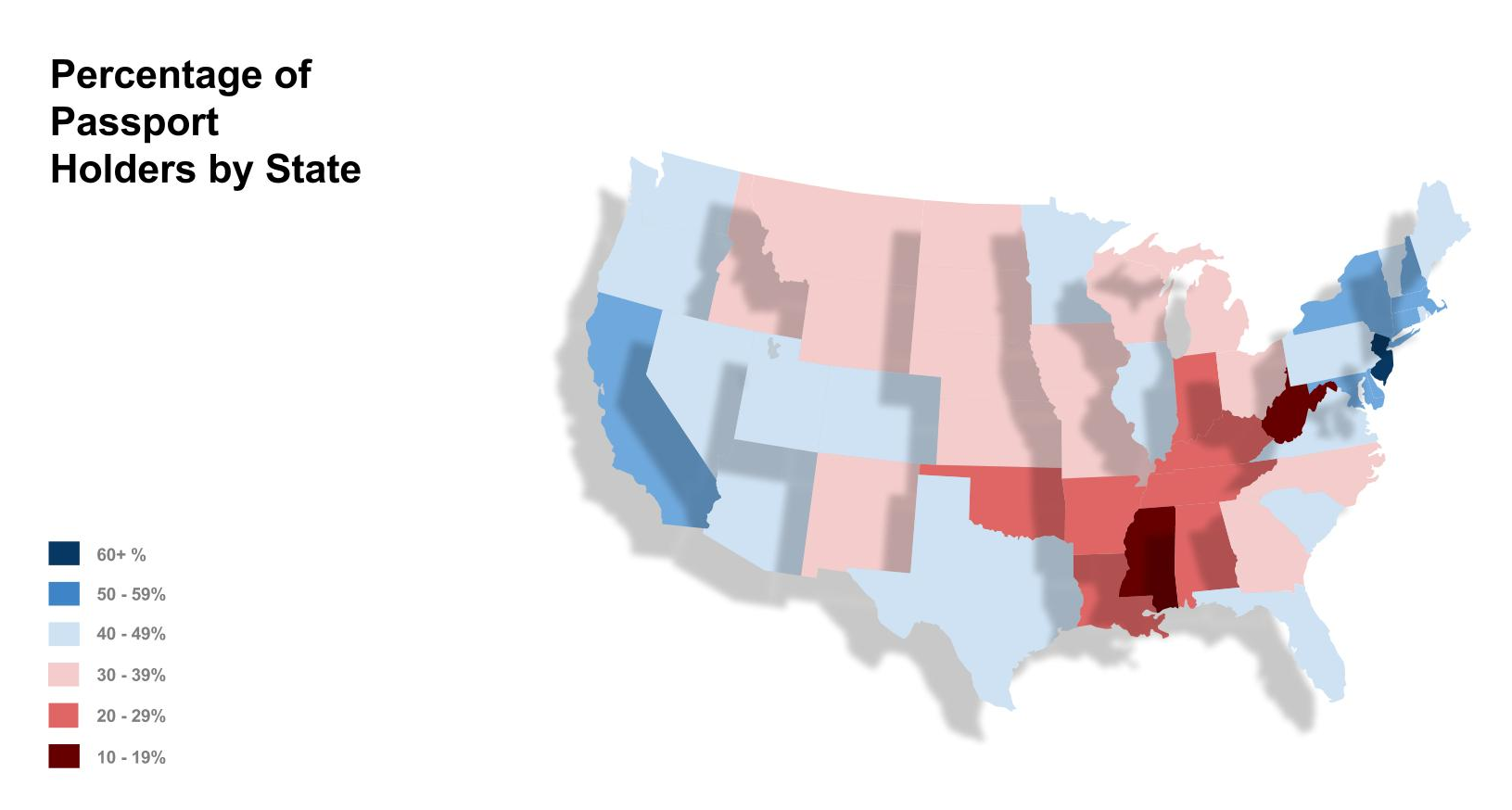
How many Americans have a passport? This was a question a British friend had asked me a few years ago, probably based upon the assumption that much of the world has about Americans, which is that the majority of Americans do not have passports. I had no idea what the answer was, so I decided to do a little research, and the answer is somewhat surprising.
The quick answer is that yes, the majority of Americans do not have a passport. The percentage of Americans who have a valid passport, according to the most recent statistics as tabulated by the State Department, is about 46%. This number excludes passport cards, which are identification cards that only allow sea and overland entry to the U.S. from Canada, Mexico and certain parts of the Caribbean, but not the rest of the world.
To get this number I took the number of outstanding valid passports in circulation as estimated by the State Department — the number is 138,675,021 — and divided that by the total U.S. population according to the Census Bureau, which as of December, 2016, was 325,103,000 (minus the approximately 11.1 million people who are undocumented residents and 13.3 million legal permanent residents that live in the U.S. but cannot obtain passports or have valid passports issued from other countries).
For those keeping score, the fact that 46% of Americans have a passport means that a little less than half the population can’t fly to Canada, let alone travel to any other country in the world.
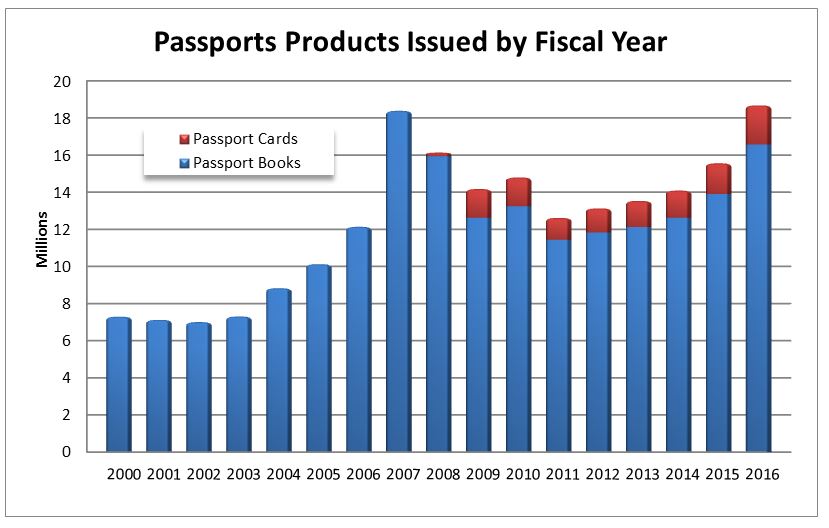
Has This Number Been Going Up or Down Year-Over-Year?
As reflected in the graphic above courtesy of the U.S. Department of State, 2016 showed a pretty healthy increase in the number of passports issued from 2015, and an overall trend upwards since the 10-year low of 2011. However, given the increase in population year-over-year, the percentage hasn’t actually gone up from 46% over the past few years.
Which States Have the Highest Percentage of Passports?
Here comes the fun part. I decided to take this data and see which U.S. states have the highest and lowest percentage of their population with valid passports. As can be viewed in the top graphic, those states with the lowest percentages are clustered in the South, Midwest, Upper Midwest, and the Great Plains States. Perhaps not surprisingly, those states with the highest percentages tended to be on the border of Canada and Mexico, along both coasts, and those states with higher urban populations.
Mississippi was the lowest, with just 17%, followed by West Virginia (19%), Alabama (22%), Arkansas (22%) and Kentucky (23%). The state with the highest percentage was New Jersey with 62%, followed by New York (59%), Massachusetts (58%), and Alaska, Connecticut and Delaware (all were at 55%).

I decided to then compare my state-by-state calculations with the results of the recent 2016 presidential elections. As can be seen above, there is a striking correlation between the states that voted for Trump in 2016 and those states with the lowest number of passport holders. Those states that voted for Clinton had the highest percentage of passport holders (Alaska is a notable exception — a state which is historically conservative, but not surprisingly has a high percentage of passport ownership given its remote location).
In fact, the top 19 states with the highest percentage of passport holders (states where at least 44% of the population has passports) were all states that voted for Clinton (Alaska was the sole exception). Alternatively, the bottom 11 states in terms of passport ownership all went for Trump.
Of the bottom half of states with the lowest percentage of passport holders, only 1 of those states went for Clinton (New Mexico). Of the top 25 states, only 6 voted for Trump (24%).
Below is a sortable list of all 50 states and the percentage of each state’s population that has a valid passport.
| STATE | PERCENT |
|---|---|
| ALABAMA | 22% |
| ALASKA | 55% |
| ARIZONA | 40% |
| ARKANSAS | 22% |
| CALIFORNIA | 52% |
| COLORADO | 48% |
| CONNECTICUT | 55% |
| DELAWARE | 55% |
| FLORIDA | 45% |
| GEORGIA | 34% |
| HAWAII | 47% |
| IDAHO | 35% |
| ILLINOIS | 47% |
| INDIANA | 29% |
| IOWA | 34% |
| KANSAS | 34% |
| KENTUCKY | 23% |
| LOUISIANA | 25% |
| MAINE | 44% |
| MARYLAND | 50% |
| MASSACHUSETTS | 58% |
| MICHIGAN | 36% |
| MINNESOTA | 48% |
| MISSISSIPPI | 17% |
| MISSOURI | 31% |
| MONTANA | 39% |
| NEBRASKA | 34% |
| NEVADA | 40% |
| NEW HAMPSHIRE | 52% |
| NEW JERSEY | 62% |
| NEW MEXICO | 32% |
| NEW YORK | 59% |
| NORTH CAROLINA | 30% |
| NORTH DAKOTA | 39% |
| OHIO | 32% |
| OKLAHOMA | 28% |
| OREGON | 41% |
| PENNSYLVANIA | 40% |
| RHODE ISLAND | 49% |
| SOUTH CAROLINA | 40% |
| SOUTH DAKOTA | 32% |
| TENNESSEE | 26% |
| TEXAS | 40% |
| UTAH | 42% |
| VERMONT | 49% |
| VIRGINIA | 44% |
| WASHINGTON | 49% |
| WEST VIRGINIA | 19% |
| WISCONSIN | 38% |
| WYOMING | 36% |
Why?
I’m probably the last person in the world to defend anyone who doesn’t have a passport, which by this very fact, completely precludes them from even the opportunity to travel outside the United States. However, rather than attempting to list out the reasons I think this is obviously not a good thing, I thought I’d propose a few reasons why this may be the case.
Money
One factor discouraging foreign travel is quite simply that it’s cost-prohibitive for the average American, many of whom are still reeling from the Great Recession. When factoring in the costs of traveling abroad from the U.S. (which tends to be much higher than other parts of the world given its location), even the cheapest international trip is simply beyond the means for the average American, especially given the lingering effects of the Great Recession and years of wage stagflation for the majority of the country.
Culture
No doubt Americans just don’t have the history and drive that, say, the British have for international travel. In the 2009 edition of The Best American Travel Writing, noted travel writer Simon Winchester had this to say on the subject:
There was essentially no empire (the Philippines, Puerto Rico, and a scattering of Pacific islands excepted), and hence little by way of imperial legacy. The country is formidably isolated by thousands of miles of ocean from almost anywhere truly foreign, and getting abroad is very much more costly. Americans seldom went to seek their fortunes overseas, as British so often did . . . [and there] is little tradition of American exploration (aside from exploration-as-entertainment put on for the benefit of a number of some rather dubious but fashionable clubs and societies).
Further, there is a lack of tradition of Americans traveling abroad given America’s size and therefore lack of need to travel to other countries to experience relatively different geographic and cultural differences.
Then factor in America’s relatively low number of paid vacation days granted by their employers, and you can quickly begin to see the many reasons many Americans simply don’t see the need to obtain a passport.
Maybe It’s Not That Bad
It’s also worth pointing out that although this number isn’t great (and certainly is far below the percentage found in countries in other parts of the world such as in Europe), at least Americans aren’t as bad in this respect compared to, say, the Chinese, where only about 5% of the population has a passport.
Finally, Americans that do have valid passports actually travel a lot. The United States ranks third in terms of the number of departures to countries other than their own (behind Hong Kong and Germany) with 68.3 million trips abroad. A good number, unless you compare that to the numbers from countries with far less populations that rank above or near the U.S. in this statistic (Germany, the U.K., Poland, Canada, Italy and France are right behind the U.S.).
How to Get a Passport
To find out how to get the process going if you don’t have a passport, all you need to do to start is to visit the official U.S. Passports and International Travel web site for the U.S. Department of State by clicking here.

/
 Matt Stabile is the Founder and Editor-in-Chief of The Expeditioner. The Expeditioner began in 2008 and is headquartered in New York City. You can read his writings, watch his travel videos or contact him at any time at TheExpeditioner.com.
Matt Stabile is the Founder and Editor-in-Chief of The Expeditioner. The Expeditioner began in 2008 and is headquartered in New York City. You can read his writings, watch his travel videos or contact him at any time at TheExpeditioner.com.
The post How Many Americans Have A Passport? appeared first on The Expeditioner Travel Site.
]]>The post The 5 Ways to Read The Directions to Happiness by Bruce Northam appeared first on The Expeditioner Travel Site.
]]>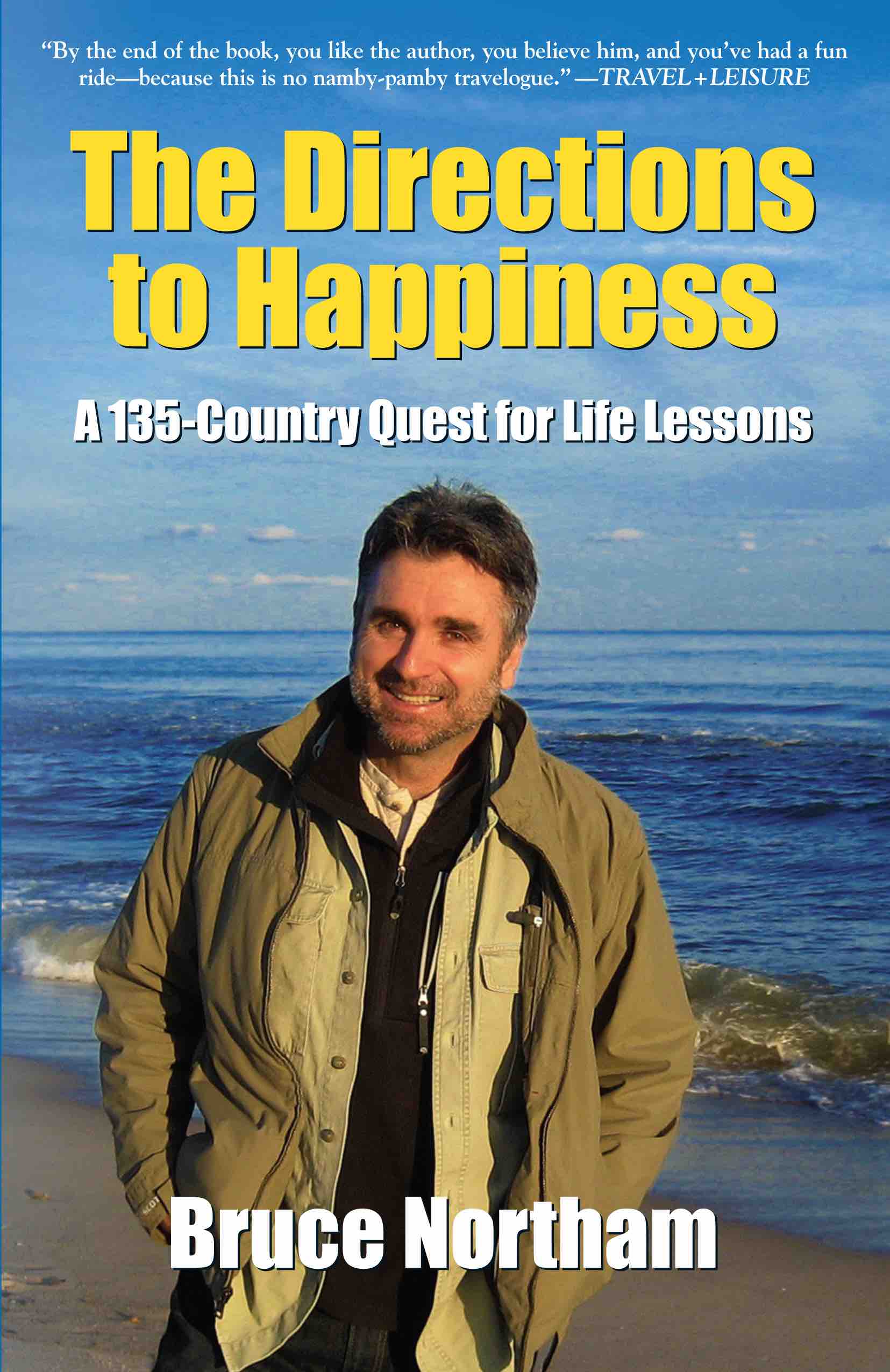
At the not-very-tender age of 35, travel writer Bruce Northam hitchhiked America from coast to coast one more time to bring awareness to the fact that it could still be done in spite of the negative P.R. the practice was receiving in the ’90s. By that time, Bruce had already been hitchhiking for two decades. His new book, The Directions to Happiness, is a lifetime of accumulated lessons given across his 30 years spent traveling in and out of 135 different countries. His “country math” was done reluctantly. As he told me, “Roaming the world should be a matter of art, not math.”
Having been able to count this New York-based author as a beer-drinking buddy of mine for the last two years, I knew I was in for some good storytelling when I loaded his latest book onto my Kindle. What I hadn’t anticipated was an integral guide that offered a thorough narrative and a compelling blueprint for finding purpose and meaning as a modern nomad.
The earnest travel wisdom coursing throughout the narrative is the sort you can’t get without spending a life on the road. Bruce is unafraid of alluding to his “vicier” days of youthful rambling, and he is unapologetic when he shares with his readers his fears the Internet culture might be fatally toxic to travel writing.
Bruce’s mischief-making followed him well past the age when most people in his age bracket begin dreaming about early retirement from the cubicles that could never hold him. He begins his narrative with tales from a childhood similar to the one led by Calvin from Calvin and Hobbes. He ends decades and 135 countries later, not owning a second home, but happy; still traveling, but settled enough to raise his daughter and to care for his aging parents.
The Directions to Happiness passes through a number of levels, from nodding wisdom to intoxicated hilarity. If you’ve been anywhere, odds are you’ll get to read about those places through Bruce’s unique lens.
Here are five ways in which the book makes a particularly compelling read.
1) The Directions of Happiness Should be Required Reading for Aspiring Travel Writers
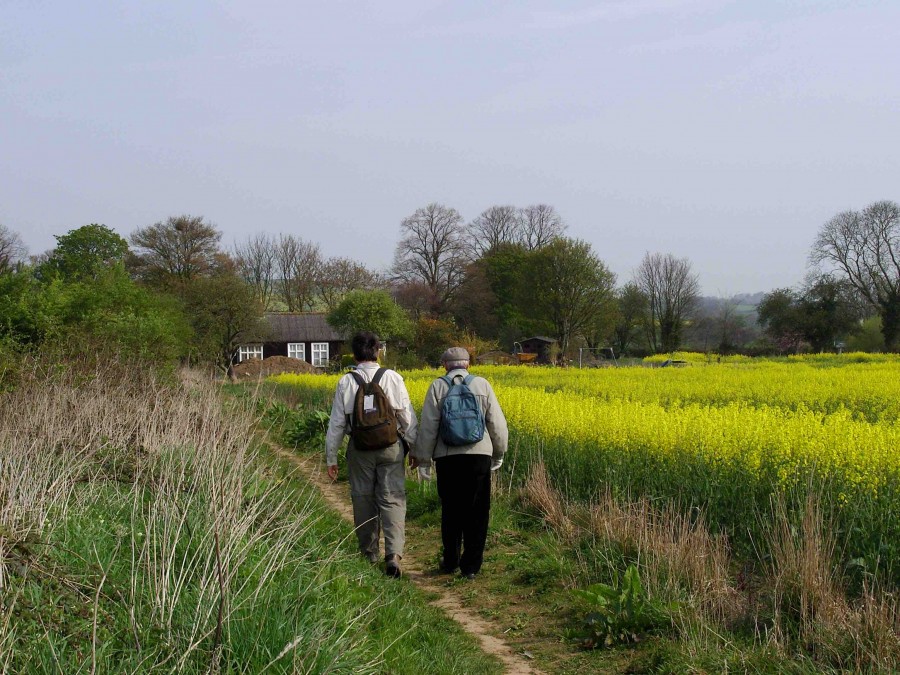
Bruce writes, “Nobody learns how to be a writer, nor a traveler. You make it happen.” Three years on, I’m still doing that, and at a certain point in the book, I stopped to take serious note. Bruce’s story is the story of a travel writer who made it. During the course of his three previously published books, he passed from varying states of financial stability, but he never gave up the fight — he was having too good a time.
“Writing about travel won’t win most fame or fortune, but it can send you and your pen to corners of the world that inspire alternative outlooks on life’s choices.” I read somewhere once that contentment is the measurement of having lived in a way that you’re proud of. The message of the book is clear: Bruce is certain he has made the right choice, and he knows he could never have found happiness by having lived any other way.
Bruce came to realize that a road well traveled and story well written were rewards of the highest rank. For me, this message is encouraging. Beyond encouragement, Bruce gives travel writers a lesson on how to be a travel writer while still providing an authentic voice. This is an important lesson today, especially given an Internet culture that seems to constantly be screaming: “Look at me!”
Throughout the book, he’s keenly aware how travel writing is changing, and he’s not thrilled that “[t]he explosion of travel content creators, especially on the web, forever changed the game. Some, who never muddy their shoes, are simply rewriting press releases where nobody ever seems to get robbed, conned, injured or laid.”
If you would like to live off travel and writing, and don’t want to contribute to international irresponsibility, this book offers an important viewpoint.
2) Read The Directions to Happiness as a Best Practices Guide to Cultural Travel
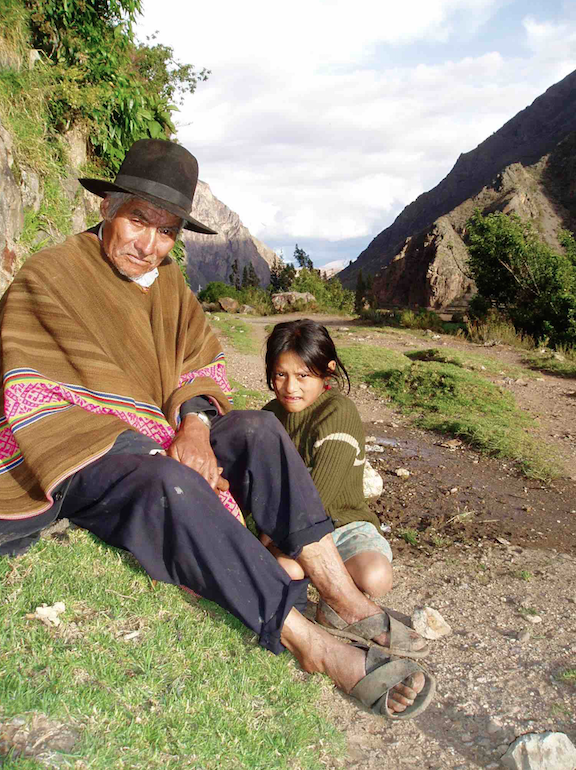
There are, in fact, right and wrong ways to travel. If you don’t think so, guess where you fall? Beyond rarely productive carbon footprint calculations, there’s a way to interact with locals where both the visitor and the visited come away better as a result of the meeting. Bruce interacts with locals as a grateful guest and offers the wisdom accumulated from these interactions.
“Don’t spend time, enjoy it,” a musician in Mozambique once told him.
“Your best teacher is your last mistake,” he learned from a Shaman in Peru.
Part of entering into another person’s world is fully leaving the world you’ve left. Bruce’s life on the road led him to see first-hand how traveling changed when Internet-connected devices started filling everyone’s packing list. This bums Bruce out. He’s not preachy, but he simply wants people to know how much better their trips will be if they “[u]nplug every now and then.”
3)Read The Directions to Happiness as a Guide on Volunteerism and Sustainable Travel
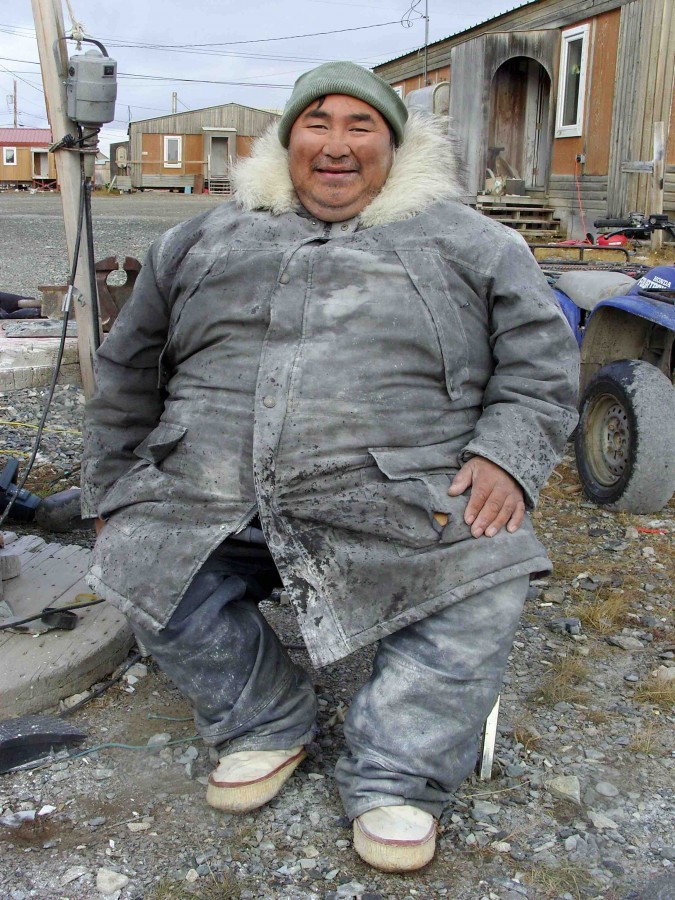
With the permission of the administration, Bruce has waltzed into many an elementary school around the world and commandeered a classroom to serve as the student’s guest teacher for a day. He has also spent time with orphanages and empowered NGOs around the world.
The lesson from this is that we don’t always need to work with a charity to make a meaningful difference, but neither do we need to shun charities. Living itself lends itself to countless human interactions, which we can steer towards positivity or negativity.
This mentality should be central to anyone dreaming of making a difference abroad. It leads to an important starting question: “Am I making a difference where I am right now with everyone I encounter?”
4) Read The Directions to Happiness As a Guide to Modern Nomadism

Living out of your suitcase isn’t always an endless adventure. Sometimes it’s hopelessly dirty underwear and troubling parasites. Considering the downsides, which include irrational fevers in lands where medicine hasn’t progressed much beyond the Middle Ages, the upsides must be truly marveling for so many people to consider a life on the road a dream life.
Living on the road teaches you there are quite a few of us out here, and while we all think our lives are awesome, we live them in defiantly different ways. When starting out, it’s important to consult those who made it out on the other side sane and not living in a cardboard box. Though I’d be the first to defend an insanity plea from Bruce, he’s certainly not living in a cardboard house beneath a bridge. Nomads, take notes.
5) Travel Philosophy as Found in The Directions to Happiness
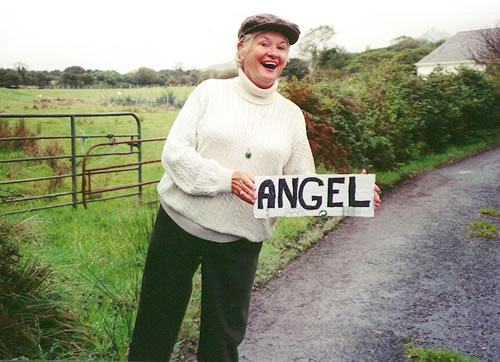
If you’ve ever read the complete works of any travel writer (or career writer for that matter), there comes a point in their career where their life philosophy progresses from fluid to established and somewhat certain. This is when they can really begin to impart their own travel philosophy to those still in their formative stage.
Bruce’s travel philosophy is a patient, non-judgmental one. He alludes to his wilder moments and reminds travelers to cherish each moment, place and person.
At one point, I stopped to reflect after reading the following passage: “Traveling makes people feel better not just because of the escapades to be had in new horizons, but also because we’re re-triggered to share our life story — and hear someone else’s.”
Living on the road, I take this fact for granted. Basically, everyday, I meet someone new, hear their 30-second elevator speech on who they are, and then I tell my own. I began to wonder: How has this impacted the people I’ve met?
*
In his epilogue, Bruce writes about how his biggest lesson compiling the book was the realization that a person living in one village for a lifetime often stumbles upon the same lofty wisdom that has taken civilizations centuries to realize.
“Someday we’re all going to realize we’re in this together,” Bruce writes. The road to get there may just be paved by those with worn soles because, “[b]roadminded, non-political solutions to the continuous warfare creeping into every shade of our planet won’t see the light until more travelers meet.”

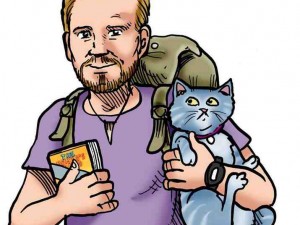 Luke Maguire Armstrong is the author of the intrepid travel collection The Nomad’s Nomad. When he’s not traveling or getting mauled by rodents in the jungle, he spends his time being rejected by girls in bars in Antigua, Guatemala. He broke his left ankle river dancing and his right ankle trying to impress the locals in Belize. Give Luke a guitar; he’ll sing you a song. Hand him a whiskey; he’ll tell you a tale. Give him both, and he’ll give you something to drink about.
Luke Maguire Armstrong is the author of the intrepid travel collection The Nomad’s Nomad. When he’s not traveling or getting mauled by rodents in the jungle, he spends his time being rejected by girls in bars in Antigua, Guatemala. He broke his left ankle river dancing and his right ankle trying to impress the locals in Belize. Give Luke a guitar; he’ll sing you a song. Hand him a whiskey; he’ll tell you a tale. Give him both, and he’ll give you something to drink about.
The post The 5 Ways to Read The Directions to Happiness by Bruce Northam appeared first on The Expeditioner Travel Site.
]]>The post Luggage Lost, Soul Found: What Traveling the World Taught Me appeared first on The Expeditioner Travel Site.
]]>
There are countless reasons not to travel: lost luggage, delayed flights, aggressive hawkers and taxi scams, to name a few. And so it was that logistical hassles, fear of the unknown and the tyranny of the status quo – not to mention the cost – all conspired to keep my wife and I grounded in the safe and familiar confines of our downtown Toronto condo. Indeed, for years, only a few touristy forays to Western Europe and the Caribbean gave us glimpses beyond the Platonic cave of our self-imposed, inverted exile.
By our mid-twenties, though, that started to change. Suddenly uninspired with the prosaic cadence of our corporate calendars (alarm-coffee-calls; meetings-TV-bed — repeat), we knew we needed to broaden our horizons. And what better way to do that, we reasoned, than to see new ones altogether.
It began modestly, to be sure. We started with the lower hanging fruit of Central Europe and Central America, before inching into Morocco, Turkey and Namibia on the peripheries of more ambitious continents. But with each successive sojourn, the travel fever deepened and the pins in our National Geographic planning map begged to colonize ever further corners of canvas. Wanderlust consumed everything: when to book trips so as to minimize work disruption, what to sacrifice to free up budget (an endless exercise), how to tell my parents we wouldn’t be home for Thanksgiving, and so on. Tanzania and Turkmenistan soon followed, with countries like Iran, Djibouti and Myanmar not far behind.
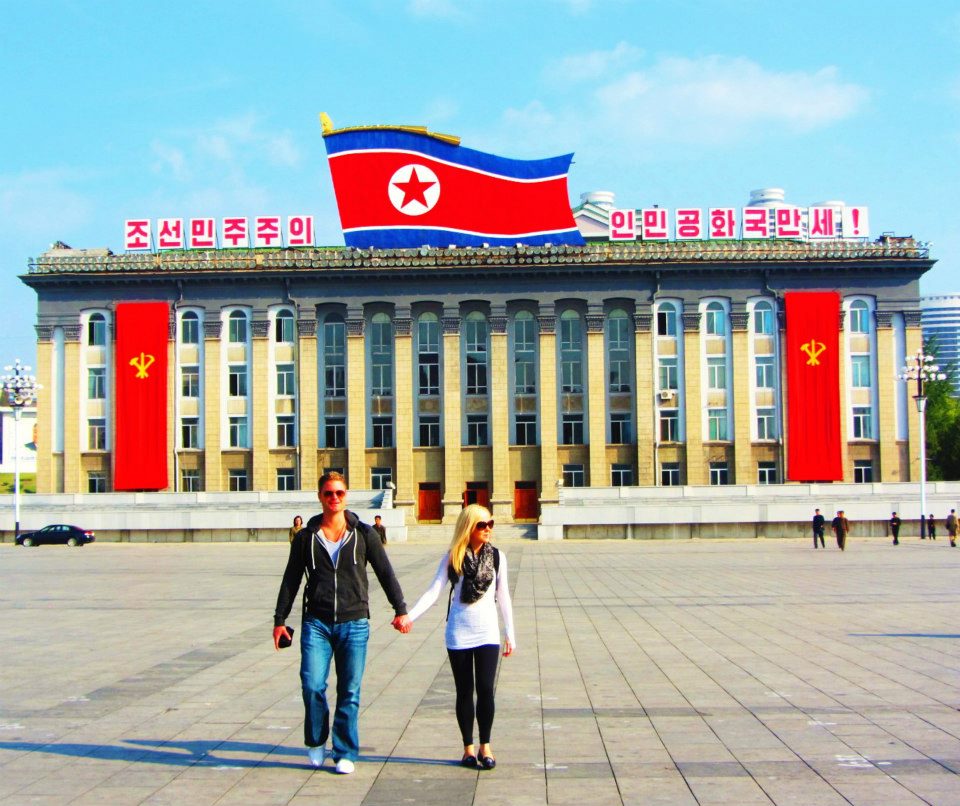
Much of what I learned in those travels these past six years has the ring of received wisdom. It’s true, for example, that people really are the same no matter where they live. Boys play soccer in the slums of Soweto with the same reckless abandon as those in the neighborhoods of New Haven, just as a preemptive smile in the hutongs of Hong Kong has equal currency to one in the barrios of Buenos Aires. Other vignettes whisked me to my own adolescence in southern Ontario, like the time when the mother of our sheepish guide in northern Azerbaijan admonished him to pack enough food and warm clothing for our long trek back through the Caucasus Mountains. Hearing my own mum speak through her Azeri avatar, I saw firsthand how differences of culture truly pale against the community of our common character.
But beyond these truisms, travel’s most telling tutorials weren’t so much about the places we’d seen, or even the people we’d met; rather, they were what they taught me about myself.
Buffeted by the gales of unexpected events and without the comforting cloak of relatives and routine back home, traveling exposed us to many of life’s elements in their rawest; from downpours and disappointments to wonderment and woe. I remember, for instance, when our 4X4 got hopelessly stuck in the washed out roads of rural Burkina Faso, and how the fear closed in with the darkness. In that eternity before local villagers found us hours later and came to our aid, we gravely weighed how the disappearance of two Canadians in West Africa might be reported back home.
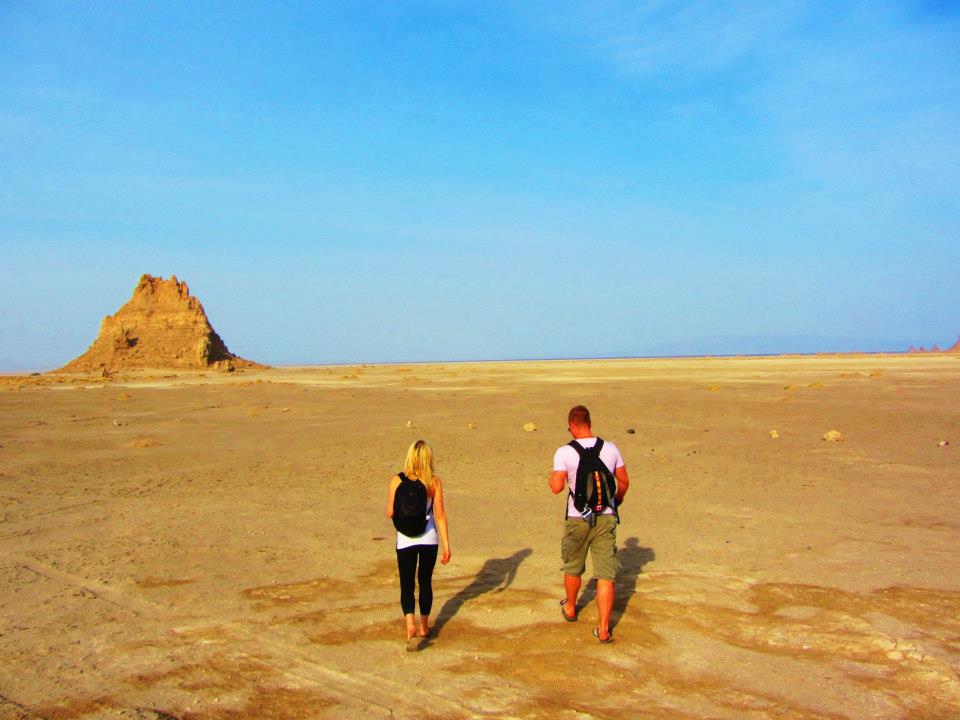
Not only did moments like this impress a healthy awareness of my own fragile transience but, far more profoundly, they syllogized a simple sermon: to travel is to feel, and to feel is to live.
The anonymity afforded as a stranger in a foreign land, too, offered instruction. Without the scripts to read or expectations to meet that choreograph our roles back home, I began to see less exclusively through my own eyes and more through those of others. I wondered, for example, whether the Syrian refugees we chanced upon in Lebanon’s Bekaa Valley more so welcomed us as curiosities or resented us as interlopers, and questioned whether our government minders in North Korea really didn’t know what pizza was or simply feigned ignorance for fear of being outed as Party apostates.
Forcing me inside the minds of others, travel challenged my assumptions and betrayed my blind spots. Seeing outward, in other words, made me look inward.
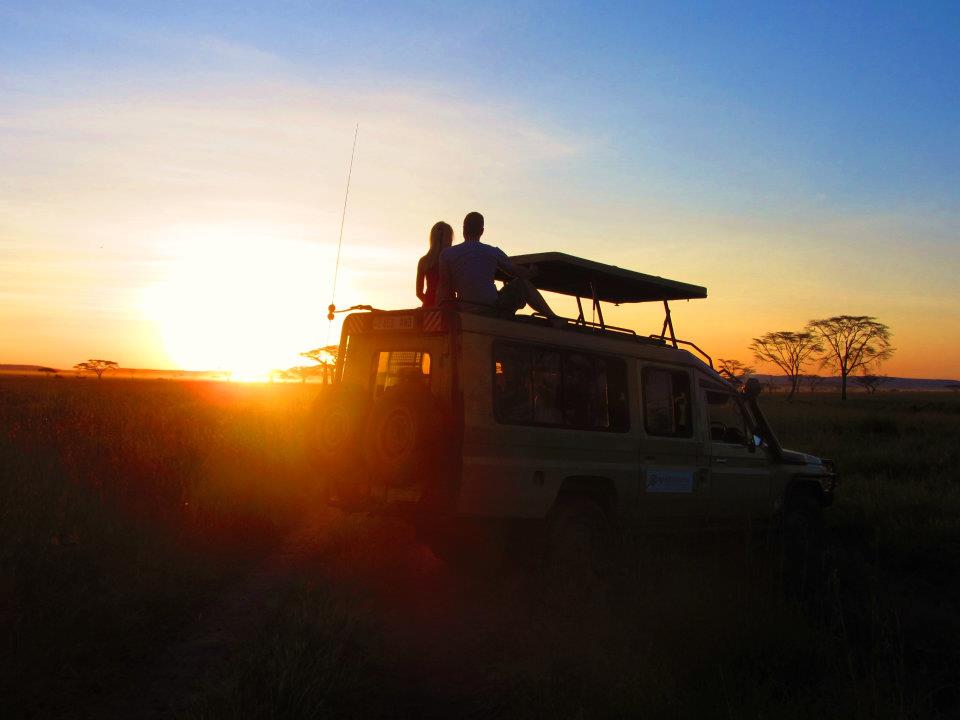
Driving this home was an entry in one of my weathered travel journals that I recently excavated from a forgotten storage bin. Pouring over it with the zeal of an archeologist on a new dig, I recounted all the staples you’d expect: logs of where we’d been, who we’d met and what we’d seen. But self-consciously hidden at the very back, as if buried in a still-deeper subterranean chamber, was a list of personality traits – all of them unflattering – that I must have cataloged about myself in a kind of introspective inventory: “Impatient, selfish, compulsive..”, the long list began.
I don’t recall where I was when I scratched this out (perhaps in the back of a Guatemalan chicken bus or on a dune of some desolate desert), but am certain that such candid self-accounting could only have been done while disconcertingly distanced, physically and mentally, from my natural element.
To me, that is travel’s true treasure. While it can surely be a window to the wider world, it is even more so a mirror to the secret sanctums of your soul; those closeted recesses that, back home, we wall off with the pretty patina of Facebook photos and drown out in the daily din of humdrum happenstance.
Sometimes to find yourself, I suppose, you first need to lose some luggage.

 Justin Williams lives in Toronto, Canada. While a lawyer by trade, his true passion lies in exploring new frontiers with his high-school sweetheart and wife of seven years, Anna. With close to 100 countries under their belt to date, their ambitious goal remains to somehow find a way to visit the rest before they turn 40. You can follow Justin through his Facebook account or the Instagram hashtag: #aroundtheworldin80posts.
Justin Williams lives in Toronto, Canada. While a lawyer by trade, his true passion lies in exploring new frontiers with his high-school sweetheart and wife of seven years, Anna. With close to 100 countries under their belt to date, their ambitious goal remains to somehow find a way to visit the rest before they turn 40. You can follow Justin through his Facebook account or the Instagram hashtag: #aroundtheworldin80posts.
The post Luggage Lost, Soul Found: What Traveling the World Taught Me appeared first on The Expeditioner Travel Site.
]]>The post The Buried Life Is Helping You To Start Crossing Things Off Your Bucket List: Here’s How appeared first on The Expeditioner Travel Site.
]]>Eight years ago, three friends and I (The Buried Life) made a “100 Things to Do Before You Die” list and decided to help people we met cross items off their own bucket list. We borrowed an RV, bought a camera on eBay, made matching t-shirts and hit the road for a two-week road trip.
Since then we have traveled the world and crossed off items from our list such as: make a TV show (#53), write a New York Times best selling book (#19), play ball with Obama (#93) and ask millions of people the question, “What do you want to do before you die?”
Over the last few years, we’ve been invited to talk at colleges and other events to both young and old, and have found that the number one item on people’s bucket list is to travel.
We’ve heard countless stories of how people wish to have grand adventures and see the rough and elegant wonders of the world. So this year we wanted to make that happen for two deserving people and give them a trip of a lifetime: traveling the world crossing off the most epic bucket list items of all time.
It’s called The Most Epic Bucket List Contest (Ever), and you get to pick 5 of 20 of our favorite list items from around the world. You choose your list, and we make it happen with the help of Contiki.
Out of the 20, I decided to list our personal five favorite items below.
#1: Swim with Sharks in the Galapagos

Spend a day in the pristine blue waters of the Galapagos snorkeling beside one of the world’s most majestic predators. Set sail and navigate through beautiful seascapes to bountiful waters filled with fish of all color. The convergence of three major oceanic currents brings an incredible mix of marine life to this area. It’s an outdoor adventure that shouldn’t be left off anyone’s bucket list. And if swimming beside sharks worries you, it shouldn’t. They are beautiful creatures with plenty of better things to eat than you.
#3: Snowball Fight on a Glacier in New Zealand

Hike up to the expansive glaciers of New Zealand and finish the day off with an epic snowball fight. We all remember the endless beautiful landscape in The Lord of the Rings, minus Mordor. Well, this is a chance to hike amidst the greenery and lushness of temperate rainforest into alpine fields while drinking from pristine glacial creeks. Travel to a 6 1/2-mile-long glacier for a long day you won’t forget.
#4: Hang Glide Over Rio De Janeiro

Travel to the highest point, count to three and set sail for a bird’s eye view of Rio. Considered one of most beautiful backdrops of any city in the world, you will have an opportunity to see it in no better way than flying over top of it. We hope you take a selfie while doing so, as it will be a moment you will never forget, and an experience that few can say they have ever had.
#13: Watch the Sunrise Over Angkor Wat

It’s tough to beat a beautiful sunrise. Include a beautiful girl or guy nestled beside you and throw in one of the world’s most historical and largest monuments and conditions are perfect for a great morning.
#15: Ski the Alps in Austria

Yes, Austria. We love Austria. Find the biggest stretch of powder you can and spend the day putting fresh tracks on the ground. If you do it right, we can promise you will be exhausted by the end of the day. You’re guaranteed to have a smile ear to ear while enjoying a delicious beverage in a hot tub overlooking a pristine mountain landscape.
*
Whether you win the contest or not, we thought we’d leave you with a few lasting words for you to be able to accomplish your own dreams and cross anything off your list. The more items we cross off our list, the more we become convinced that anyone can do anything.
The formula comes down to these steps:
1. Stop and Think About It
What is it that you really want to do with your life? Don’t wait for a crushing loss to force you to think about what’s important to you.
2. Write It Down
Simply put, it’s not real until you write it down. Take your dream and turn it into a project. Dreams have a funny way of staying dreams, but a project is something that needs to be done. Approach it as you would any other item on your daily or weekly to-do list.
3. Talk About It
After you’ve come up with your list and written it down, start talking. Tell everyone you know. Don’t keep it to yourself as help can show up in the most unusual places, oftentimes the least expected ones.
4. Be Persistent
Most people give up just before they reach their goal. We all hear “No” a lot, but “No” sometimes just means, “Not now.” Be creative in your persistence. Think of innovative and clever ways to grab their attention. Be different, and never say die.
5. Be Ballsy
99% percent of people believe they cannot do great things, so they aim for mediocrity. The level of competition is highest for realistic goals because most people don’t set high enough goals for themselves. Statistically, you have a better chance of achieving what may seem like an unrealistic goal.
*
Your dreams are closer then they appear. There’s nothing about us four guys that makes us more able than anyone else to accomplish our goals, other then the simple fact that we decided to go after them. As George Elliot said, “It’s never to late to be what you might have been.” Don’t wait. Why not start now?
Much love,
Ben from The Buried Life

The post The Buried Life Is Helping You To Start Crossing Things Off Your Bucket List: Here’s How appeared first on The Expeditioner Travel Site.
]]>The post Slavoj Zizek On Starbucks And The Hidden Price Of Consumerism appeared first on The Expeditioner Travel Site.
]]>The following is a transcript from the above excerpt from my favorite part of The Pervert’s Guide to Ideology, the 2012 British documentary featuring everyone’s favorite Slovene philosopher and psychoanalyst, Slavoj Zizek, and which was directed by Sophie Fiennes (of the Joseph and Ralph Fiennes clan).
I somehow missed the movie when it was released a couple years back in theaters (the general viewing public wasn’t exactly lining up around the street to get into screenings), but it has recently been released here in the U.S. on Netflix and is available for viewing anytime.
*
Let’s turn to the high point of our consumerism. Let me take a drink.
Starbucks coffee. I’m regularly drinking it, I must admit it. But are we aware, that when we buy a cappuccino from Starbucks, we also buy quite a lot of ideology? Which ideology?
You know, when you enter a Starbucks store, it’s usually always displayed in some posters, their message, which is: “Yes, our cappuccino is more expensive than others,” but, then comes the story.
“We give 1% all our income to some Guatemalan children to keep them healthy, for the water supply for some Saharan farmer, or to save the forest, to enable organic growing for coffee, or whatever or whatever.”
Now, I admire the ingenuity of this solution. In the old days of pure, simple consumerism, you bough a product, and then you felt bad. “My God, I’m just a consumerist, while people are starving in Africa . . .”
So the idea is that you had to do something to counteract your pure, destructive consumerism. For example, I don’t know, you contribute to charity and so on.
What Starbucks enables you, is to be a consumerist, without any bad conscience, because the price for the countermeasure, for fighting consumerism, is already included into the price of a commodity. Like, you pay a little bit more, and you’re not just a consumerist, but you do also your duty towards the environment, the poor, starving people in Africa, and so on and so on.
It’s, I think, the ultimate form of consumerism.

/
 Matt Stabile is the founder and Editor-in-Chief of TheExpeditioner.com. You can read his writings, watch his travel videos, purchase the book he co-edited or contact him via email at any time at TheExpeditioner.com.
Matt Stabile is the founder and Editor-in-Chief of TheExpeditioner.com. You can read his writings, watch his travel videos, purchase the book he co-edited or contact him via email at any time at TheExpeditioner.com.
The post Slavoj Zizek On Starbucks And The Hidden Price Of Consumerism appeared first on The Expeditioner Travel Site.
]]>The post What’s It Like To Drop Everything And Sail The World? This Man Decided To Find Out appeared first on The Expeditioner Travel Site.
]]>Life on a boat, does life get any sweeter than that?
I recently came across this great short documentary about Canadian sailor/expat/dropout David Welsford called “Twenty Eight Feet: life on a little wooden boat,” which takes a look at Welsford’s decision to give up the luxuries of land in search for happiness and adventure on a 50-year-old wooden boat he restored from a scrap heap.
The film, from director and cinematographer Kevin A. Fraser, has been making the rounds on the film festival circuit, including the Maui Film Festival and the Atlantic Film Festival.
Obviously, Welsford has a unique view on money and people’s relationship with it, and his thoughts made for my favorite quote of the movie: “I think I understand money, in my way of understanding money, which is, once you figure out to make enough, then go do the things the may you happy.”
[Twenty Eight Feet: life on a little wooden boat]

/
 Matt Stabile is the founder and Editor-in-Chief of TheExpeditioner.com. You can read his writings, watch his travel videos, purchase the book he co-edited or contact him via email at any time at TheExpeditioner.com.
Matt Stabile is the founder and Editor-in-Chief of TheExpeditioner.com. You can read his writings, watch his travel videos, purchase the book he co-edited or contact him via email at any time at TheExpeditioner.com.
The post What’s It Like To Drop Everything And Sail The World? This Man Decided To Find Out appeared first on The Expeditioner Travel Site.
]]>The post 10 Ways To Improve The Flying Experience Outside Of The Plane appeared first on The Expeditioner Travel Site.
]]>
On my way to a recent flight, while I was frantically putting my shoes back on among a pushy crowd in that tiny space past the scanning machine, my mind began to wander from its immediate train of thought (which, at that moment, included a fantasy involving my shoe coming into contact with the person’s head behind me) to one that was slightly more peaceful and productive: How can the process of flying be improved outside of the plane?
It’s no secret the flying experience doesn’t exactly rate at the top of most people’s list of pleasurable activities they endure in life (tax preparation and colonoscopies are probably close runner-ups). However, I began to think there must be a number of easy, inexpensive ways the overall flight experience outside the plane could be improved, and which could help in reducing stress, adding comfort and making the task of getting from point A to point B slightly less painful than the current Hunger Games-like experience it is now.
In that spirit, here are 10 of my ideas.
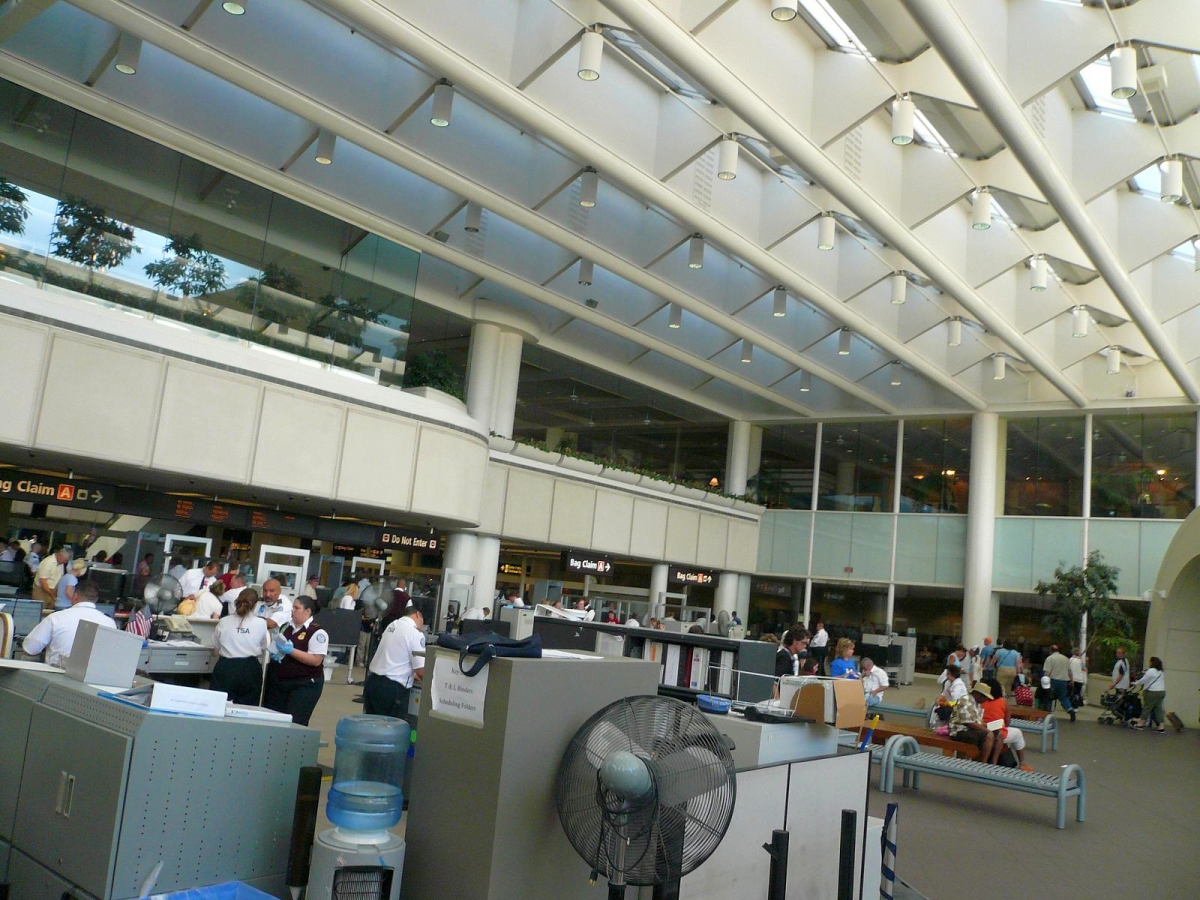
1) Improve the Scanning Machine Area
Why must the process to collect our belongings at security be so difficult? Not only does each person likely have a bag or two being scanned, but they probably have at least one or two separate bins making their way down the scanning machine conveyor belt filled with their keys, laptop, jacket, carry-ons and shoes. After scanning, the TSA expects you to collect all of these items, organize them and be on your way — shoeless I may add — in a matter of seconds before the person’s belongings behind you comes barreling into yours.
I know this area is oftentimes restricted by the layout of the terminal, but why must everyone cram together in the same tiny space while frantically attempting to collect their things, stick their computers in their cases, put their shoes on and stuff their keys and loose change in their pockets once everything’s been scanned?
Why not extend the length of that portion of the conveyor belt to accommodate at least three or more people and their belongings? If there isn’t enough space to do that, just move up the scanning machine itself. There only needs to be space enough for one person to load their belongings at the beginning. Plus, that would likely lead to less of a logjam at the end.
Or, if it hasn’t been done already, how about every security area set up waist-high tables next to the conveyor belt? Then you can simply grab your items and quickly transfer them to an area away from the conveyor belt.
I know some terminals are simply making do with what space they have, but it would make more sense to plan the layout beginning with the exit area first, then going from there.
2) Why Must I Walk So Much?
It’s the year 2014, and I was told we would have flying cars by now. Not only are we still using old-fashioned land-based cars, but we still have to walk ages just to get to our gate. Seriously, have you timed how long it takes to get to your gate from security at a major airport? If you’re at the end of the terminal, you could easily be looking at a 15-minute walk.
Myself, I don’t mind getting in as much footwork as possible before settling into a sedentary position for the next few hours, but I sincerely feel for the elderly, those with disabilities or those who happen to be running late for their flights. Sure, there are a few walking escalators here and there, but come on, they’re rarely longer than 100 feet long, so they shave off, what, 15 seconds?
When mall cops zip around on Segways and airport personnel scoot around on golf carts, why can’t we come up with a more efficient way to get people where they’re going?
How about walking escalators that are 10 times longer than the normal ones? Certain escalators could be “express” if they’re bypassing a number of gates. What about indoor trolleys that circle the terminal, slow enough to allow people to hop on and off, but quick enough to shave real time off your walk? Golf cart taxis, bike-shares, whatever, but let’s rethink the process of how we’re getting to our gates.
3) Universal Wi-Fi
I know many airports are improving their access to Wi-Fi, and a few around the world are actually implementing complimentary Wi-Fi in their terminals, but most are still dead zones in this regard.
Sure you can shell out $30 to rent Wi-Fi for a few hours by a third-party service such as Boingo or AT&T, but why would I want to? That costs as much as I pay for one month of high-speed broadband at home. My guess is the number of people who actually pay for this service a day could be counted on two hands.
The fact is, the technology is getting cheaper and easier to install. How about airports shell out the money and make it free for everyone? If the airports need the extra revenue to support the service, they can sell ad space on a few signs around the terminal, allowing companies to “sponsor” the free internet. We’re in 2014 in a developed country; there’s no excuse not to offer free, reliable internet access in our major transportation hubs.
4) Fix Zone Boarding
It’s time to do away with “zone boarding.” The truth of the matter is, allowing passengers to board according to zone is simply the most inefficient way to quickly seat everyone (which, I may add, helps with on-time departures — a goal of all airlines).
Further, as soon as one zone begins to board, every single person in every other zone begins to line up themselves, as if they risked not getting a seat if they weren’t front and center the second their zone was called. The reality is, they know the sooner they get on, the better chance they have of fitting their carry-on luggage onboard.
Why don’t all airlines board passengers randomly? A two-year study by American Airlines showed that boarding passengers by random assignment shaved three to four minutes off of boarding times. Not a huge difference, but noticeable enough to warrant change.
Or, how about boarding all window seats first, then middle seats, then the aisle, starting from the rear, like United does? I always fly by the window, and I swear to God, every single time I get to my row, both other passengers are already sitting in their seats. If window seat passengers were seated first, then the time needed for people to get up and make way for others would be eliminated.
5) Fix Ground Transportation Signage
This one applies once you’ve left the airplane and are making your way home. I’ve obtained a law degree and have traveled to over 30 countries in the past 6 years, and even I am continually perplexed and bewildered by the signage (or lack thereof) on how to exactly get from baggage claim to my destination in most cities. (God help the newbie visitor to New York City navigating the ground transportation options at one of its airports.)
The truth is, the planning that goes into airport design for the terminal section where baggage and ground transportation meet is obviously an afterthought for most architects when designing terminals. My guess is they rightly know very few baggage claim areas make their way into glossy magazines or architectural publications upon completion, so why spend much thought into their design? The reason: because it’s so crucial to the flying experience.
We may not be able to redesign airport terminals, but let’s at least improve these areas. How about mandatory kiosks in the middle of the baggage claim where staff can easily answer questions, provide maps and point out proper exits while you’re standing around for 20 minutes waiting for your bag? Sure you can refer to a sign or read a pamphlet, but nothing beats talking to a real human being for directions (especially if you can’t read the local language).
Let’s also institute some sort of universal signage system for exits: large green signs for taxis, blue for subways or trains, yellow for buses and red for parking (and let’s throw in some universal symbols for each just in case someone just happens not to speak English).
There could also be a cooperative web site that gathers all this information, so all you had to do after landing was pull up one site or app on your phone and check out your options rather than having to search each airport’s website for information.
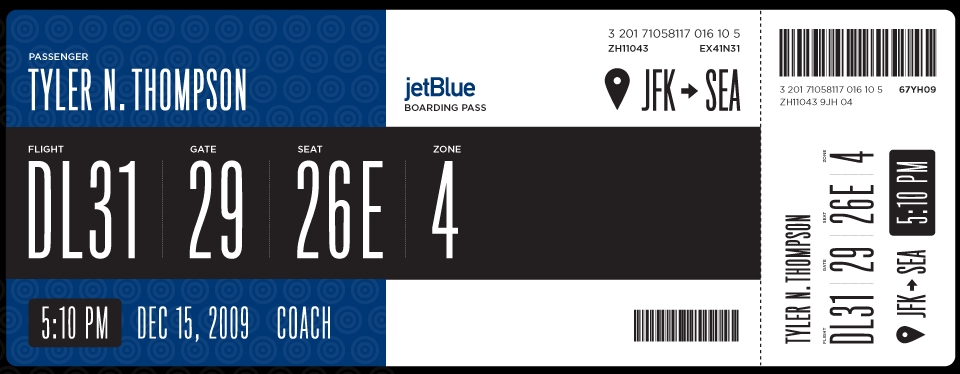
6) Fix Boarding Passes
Though boarding passes are increasingly going digital, the ugly truth is these paper remnants are going to be around for the next few years. So, while we’re stuck with them, how about making them somewhat readable? Information seems to be placed randomly, the text is small, and worst of all, you would never want to keep them after your flight (I, for one, would love to keep boarding passes as mementos).
The internet is rife with designers’ reimaginings of boarding passes. There’s a great design floating out there that places the flight number, gate, seat assignment and zone in large, white text against a black background in the middle of the pass, then splashes the airline’s logo colors in the background and relegates the bar code to a small section in the bottom right corner. Other designers have suggested using graphics to distinguish different information (boarding zones, seat numbers and flight time), reducing pass sizes so they would fit neatly in your wallet or adding colors and a logo to the back.
Though likely not a huge priority for airlines looking to save every penny they can, in the age of corporate homogenization, little touches like these can be the difference between a customer distinguishing one airline over another, and ultimately booking with them at the time of purchase.
7) Sell Me Services and Items at the Gate
I’m all for the airlines making more money, especially in ways that don’t impact the cost of my actual ticket. Over the last few years, airlines have done wonders improving their bottom lines by making money off of everything but putting your behind in the seat. Checked baggage, preferred seating, seating upgrades, in-flight meals, on-board entertainment, in-flight internet — you could easily rack up costs that total more than half your ticket price on just these add-ons alone, but why not offer some services that I really want and that I could purchase before I even got on the plane?
While I’m sitting at the gate using my newly free Wi-Fi, why not offer me a boatload number of ways to spend more of my money (or set up roaming kiosks that could be moved from gate to gate)? While waiting I could rent a pair of noise-canceling earphones or a premium blanket and pillow for my flight. I could also be given the chance to order a variety of different food options that could be delivered to me just in time for boarding.
What about last-minute toiletries I may need during my connection like toothpaste, a toothbrush, mouthwash, contact lens cleaner, ibuprofen, etc . . . ? The list goes on: a replacement phone charger, change of socks, baby formula, a hardcover bestseller, a back massage — these are all small items that could be sold at a premium to a captive, needy population, many of whom would be happy to pay the extra money for the convenience while they wait at their gate. Why should airlines lose out on all this potential revenue to vendors in the terminal?
8) Sleeping Chambers
This isn’t a novel idea — U.K.-based Sleepbox is a leader in this field — but why aren’t there sleeping chambers in every airport terminal?
Think of the number of flyers relegated to catnaps in uncomfortable seats during long layovers, overnight delays or during cancelled flights.
Imagine how nice it would be to rent out a small area where you could store your belongings and settle into a comfortable bed with clean bedding and no noise for a few hours. Many people would probably fork over a donation of their own plasma, let alone $50, for a couple hours to do this. There could also be noise-free private areas the size of cubicles where business people could work remotely without outside noise interference, families could congregate in private or parents could rest with their children who want to nap.
9) Reward Flyers Who Check Their Bag at the Gate
There’s an odd Kabuki-like ritual going on between airlines and passengers when it comes to checked baggage. The airlines want to charge you for checking baggage so they can boost profits, but flyers don’t want to pay the fees, so too many people bring too much baggage onto a plane with not enough space to handle it. The end result: airlines almost always have to make an announcement for voluntary baggage check-in at the gate to free up room.
Yes, it’s complimentary, but shouldn’t flyers be rewarded for helping the airlines in this ridiculous game?
I’ve checked my bag at the gate for every domestic fight I’ve taken in recent memory. Shouldn’t I be rewarded for doing so? Okay, I’m not donating a kidney or solving world hunger, but with my help, the airlines are able to keep up this charade and continue to reap profits for checked baggage.
Why not offer me a free upgrade for every 10 bags I check at the gate (which, in my estimation, is equal to about 2 1/2 hours of time I will spend waiting at the baggage carousel)? Or how about points, a free meal or even a Tweet thanking me? Instead, I get a luggage receipt, a curt thank you and am sent on my way.

10) Improve Gate Seating
Finally, there’s probably no easier way for airports to improve the flying experience than simply upgrading the way we wait for planes at the gate. Stiff seating, TVs blaring CNN and lack of amenities: Why is the seating area at the gates no different than if you were at the doctor’s office? Actually, scratch that, a recent visit to my doctor revealed they’ve actually far surpassed airports in this regard.
Some improvement could be minor: electrical plugs and USB ports at every seat, mixed seating options (shared seating, recliners, foot rests, workstations) and turning off the TVs. Other improvements could be peppered throughout the gate such as personal monitors for individual entertainment options, shared desk spaces for groups to socialize or work, cafe-like seating for all those people eating while waiting at the gate and more open space for children to play.
I would suggest a designer simply spend an 8-hour day sitting at a gate with a pen and notebook and observe how people actually spend their time there waiting. My guess is they would come up with a list of about 50 other ways this area could be improved from its present, purely functional state. The above image for the “Schiphol Innovative Gate” in Amsterdam would be a good start.
*
Sure, improving the flying experience isn’t likely going to determine whether the millions of people that fly every day continue to do so, but small changes in the way we live our lives do make an impact on the world.
With the advancements in technology and the increase attention companies spend thinking about the customer experience to gain a competitive advantage over each other, the flying experience should not be excluded in reaping the benefits. Let’s start rethinking the flying experience outside the plane and bring back the joy of travel to all parts of the trip.

[Schiphol Innovative Gate courtesy of Philips; TSA Security Line Orlando International Airport by Michael Gray/Flickr; Boarding Pass by Tyler Thompson]
/
 Matt Stabile is the founder and Editor-in-Chief of TheExpeditioner.com. You can read his writings, watch his travel videos, purchase the book he co-edited or contact him via email at any time at TheExpeditioner.com.
Matt Stabile is the founder and Editor-in-Chief of TheExpeditioner.com. You can read his writings, watch his travel videos, purchase the book he co-edited or contact him via email at any time at TheExpeditioner.com.
The post 10 Ways To Improve The Flying Experience Outside Of The Plane appeared first on The Expeditioner Travel Site.
]]>The post Ducks, Drugs And Dance Meditation: My Failed Stay At A Nicaraguan Permaculture Farm appeared first on The Expeditioner Travel Site.
]]>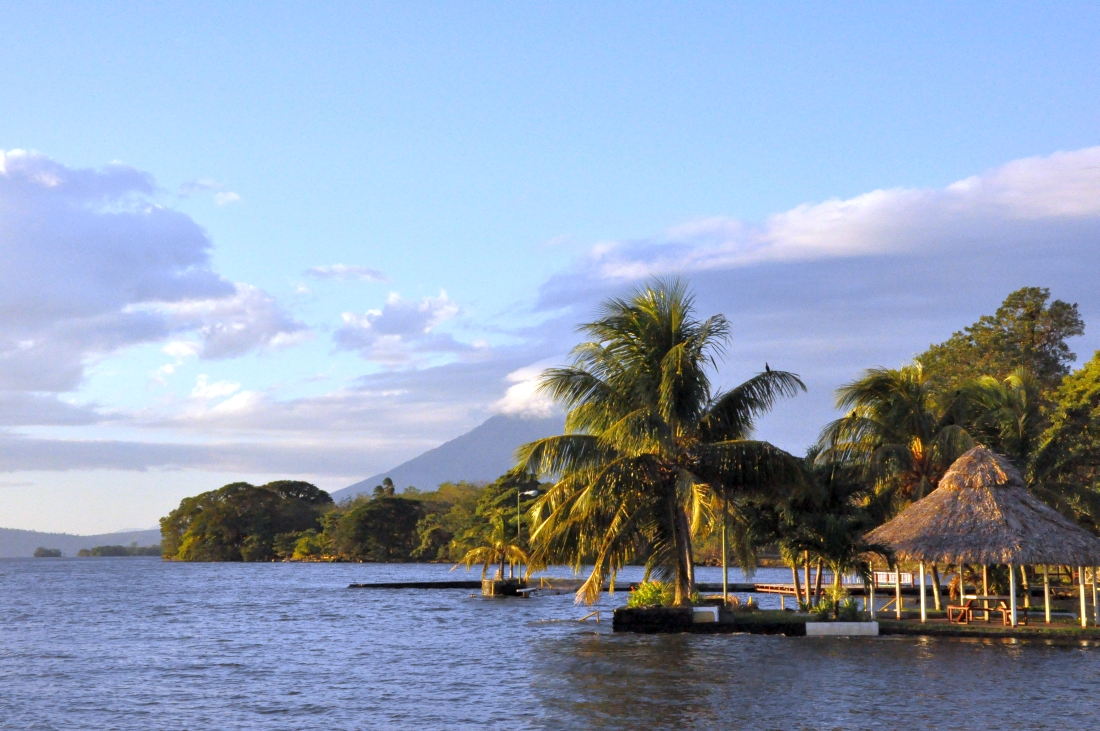
The man walked blindfolded between our outstretched fingers as we caressed him with leaves and feathers. Other hands reached out to caress or hold him.
“You are loved,” someone whispered.
“I love you,” echoed another.
He ended his walk in the arms of the oldest man and woman on the farm. They cradled him as would a mother and father, rocking him gently. This unusual birthday ritual captured in a nutshell my stay at a remote permaculture farm on Nicaragua’s Isla de Ometepe — a loving, community-centered experience that managed to both charm and profoundly weird me out.
I was fresh off a week-long spiritual retreat in Lake Atitlan, Guatemala. I’d left refreshed, relaxed and ready to put aside my Toronto-forged cynicism. I’d traveled down by chicken bus and ferry to this farm caught in the dip between two volcanoes, one fire and one water.
My first impression of the property seemed to promise further connection to the earth, self, and community — all things which I’d begun to foster in Guatemala. The farm was run on solar power and had a big garden filled with local crops. Its bounty fed the farm’s full-time staff, volunteers and visitors. Additional supplies such as grains were almost all local. There was a rustic open kitchen, a meditation hut with views over the palm-filled valley, a library and hangout center, and a pool with sweeping views of the fire volcano and the lake far below.
An elfin blonde beauty with freckled blue eyes and nicotine=stained teeth showed me around. I waxed poetic about the farm to her. It seemed like the hippie colony I had wished for and yet had always misanthropically avoided.
It all started to unravel that night. I was sitting on a rock bench in the open kitchen and enjoying the rich scent of yucca cooking in coconut curry when a tall and lanky guy with Napoleon Dynamite glasses sat next to me. He skipped the small talk and instead began to stroke my back. I instantly freaked out. One of the interesting things about getting out of your comfort zone is realizing how small that zone really is. It only took one (supposedly) innocent touch to put me out of it. That was only the beginning.
At least I was faring better than the duck that was on its way to the lower field teepee. A retreat was on and the participants were to meet the duck before he was made into soup. After this an intense night of drumming, chanting and imbibing of some beverage that would induce lucidity was scheduled to begin. Even the smallest amount of marijuana pulled me into an abyss of fear, so this all sounded incredibly sinister. I’m sure the duck would have agreed.
The next day I decided that I had to make inroads with the other folks staying at the farm. Trying to be a joiner, I trekked 30 minutes downhill to the closest restaurant with a few other residents. I chatted up a bronzed Canadian who was head cook in the kitchen. He confessed that he grew pot in British Columbia half the year and traveled the rest. He was at the farm to try to clean up his act and face his demons. He was a former party boy with a golden face and a haughty manner and he seemed deeply uncomfortable with himself and most other people. I resigned myself to the fact that he wasn’t going to be my new best friend.
I turned to a didgeridoo-playing Dutch guy instead. I quickly found out that he had the unnerving habit of staring right through you while asking overly personal questions. He posed them as if he was riding on some sparkling wave of honesty when in fact he was in the no-beeswax zone. I had heard him playing his instrument down the hill, the low eerie sounds wafting out of the tall grasses.
At least the gooey oven-cooked pizzas and I got along. I sat on a park bench and watched lithe women glide by in brightly patterned harem pants, belly tops and dreads. We eventually walked back to the farm together along the snaking path, the stars blotting out the sky above with their dazzling scatter. The total darkness obscured my steps. I stumbled over rocks and roots and ducked underneath almost invisible strands of barbed wire.
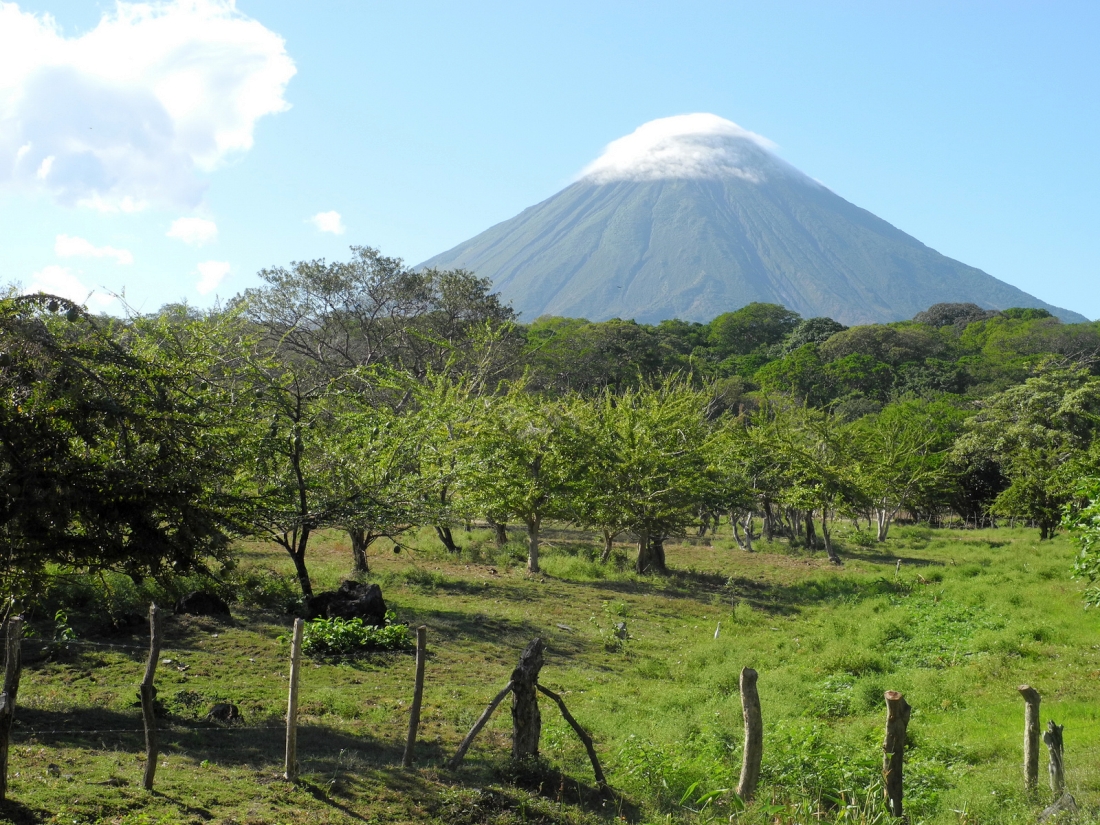
Monday morning rolled around and with it came the return of yoga and meditation classes. I was relieved for a bit of structure and decided to throw myself into getting in touch with the inner me or God or whatever happened to be there.
At 5 a.m. I groggily stumbled towards the tree-top Jungle House. I expected the rest of the crew, but to my surprise, only the owner, Jane (a serious woman with long dreadlocks and a sinewy yoga body) and her German boyfriend were there. I was the only student.
They instructed me to let me body move, vibrate or emit sounds as it liked while a feral-sounding electronic music played at top volume in the background. I never felt more rigid in my life, except for when my boyfriend had tried to teach me salsa dancing. I stood there with my eyes closed while tapping my foot and praying for the whole thing to be over.
Yoga wasn’t much better. Most classes were taught by volunteers who had recently completed their teacher training. The worst class by far was led by my back patting friend. He decided that leading us through traditional yoga poses was too square and turned the whole session into an impromptu laughter yoga class.
Back-patter started making up moves and laughing his crazy hyena laugh. The pot dealer/head cook proceeded to crack up which precipitated a chain of frantic laughter while we all sprawled in ridiculous poses. It was kind of great, except that I really wanted to stretch and I hate laughing. The latter point is mostly not true.
The whole experience was kind of harmless in and of itself. The lame classes, the angry hippies, the strange rituals and random cuddliness were somewhat balanced by the intense and savage beauty of Ometepe, the relaxed pace of life and the delicious vegetarian food that was heavily laced with succulent coconut, fresh cacao and curry.
What tipped it all into the red was José, the farm’s carpenter. Native to the island, he was short, deeply tanned and had a mouth full of silver fillings. I’d quickly taken to him. He thought the farm’s hippies were ridiculous and since my cynical defense mechanism had kicked back in he proved to be a much-needed friend. I gave him English lessons, ate dinner with him and answered his barrage of questions. I knew that his intentions were no purer than those in the hearts of the hippies around me but I figured I could keep him at bay.
Still one night he invited me to sleep with him in his loft space and everything came crashing in. I realized that I was stuck on the farm in the middle of nowhere with no ally, no sense of purpose and definitely no inner peace. I was deeply uncomfortable. I begged Jane to let me out of my 10-day commitment.
She let me go though not before looking deeply into my eyes and saying, “You think people don’t notice Bronwyn but I see your pain.”
I stumbled back down the rugged path towards the village, tears stinging in my eyes and my pack weighing heavily on my back. I’d said a quick goodbye to José before I left.
“You will forget me,” he’d said before I hurried off.
He was right, I would forget him. What I wouldn’t forget was how I’d had a terrible experience in a supposed spiritual paradise. Some of it was due to bad management and the rest came from my inner resistance and inflexible boundaries. My last encounter with Jane showed me that there was a vein of giving that I had refused to mine.
I realized that Guatemala had showed me my best self while Nicaragua had shown me my worst. I was as surprised by my own reactions as the people and places I’d encountered and I needed to process that experience. And avoid hippie birthday parties at all costs.

[Isla de Ometepe by Eric Molina/Flickr; Volcán Concepción by m.a.r.c./Flickr]
ABOUT THE AUTHOR
 Bronwyn Kienapple is a freelance writer and Canadian who’s currently lost in Southeast Asia. Her writing has appeared in such publications as Torontoist, The Grid and Toronto Standard. She recently contributed to the literary cookbook Eat It: Sex, Food & Women’s Writing.
Bronwyn Kienapple is a freelance writer and Canadian who’s currently lost in Southeast Asia. Her writing has appeared in such publications as Torontoist, The Grid and Toronto Standard. She recently contributed to the literary cookbook Eat It: Sex, Food & Women’s Writing.
The post Ducks, Drugs And Dance Meditation: My Failed Stay At A Nicaraguan Permaculture Farm appeared first on The Expeditioner Travel Site.
]]>The post 6 Questions For The Girl From “The Craziest OkCupid Date Ever” appeared first on The Expeditioner Travel Site.
]]>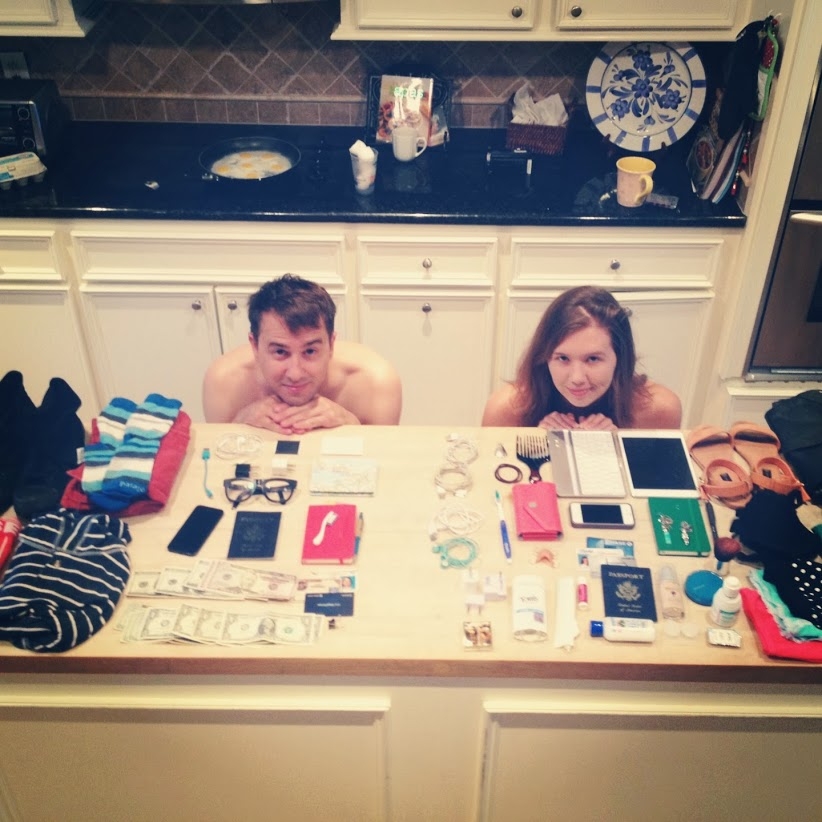
If you’ve been anywhere near a computer at all this week, chances are you’ve come across “The craziest OkCupid date ever,” the highly click-worthy article that was published by Salon on Monday, and which has since gone completely viral (over 16,000 shares on Facebook alone as of today).
The story chronicles the 21-day, ultra-minimal trip to Europe taken by Austin-based freelance writer Clara Bensen (ClaraBensen.com) and her date Jeff, whom she had recently met on OkCupid. Despite being in a relationship for less time than most of us go without getting a haircut, the two embarked — at Jeff’s suggestion — on a trip to Europe where each packed nothing more than what could fit in their pockets (and one small shoulder bag), which begs certain obvious questions regarding sanity, hygiene, the role of modernity in contemporary travel, our reliance on technology, and practical questions about washing one’s clothes with no spare clothes on hand.
Lucky for you, we tracked down Clara, who agreed to candidly answer our more pressing questions about her trip, the role of ultra-minimal travel in the world today, and most importantly, whether she and Jeff made it through to the present, relationship intact.
1) When I first clicked on the article, I thought I was going to read about a couple’s first date where they ended up in Budapest by the end of it. However, after reading a bit in, it appears you knew Jeff for about 6 weeks before heading off on your ultra-minimalist trip where neither of you brought much of anything for an 8-country, 21-day trek. How well did you really know Jeff up until that point, and how much more do you think you knew him after the trip was done?
Yes, you’re right. Jeff and I met online in April, bought the tickets four weeks later in May and boarded the flight to Istanbul in June. Some people interpreted the Salon article title as if we never met in person before embarking on the trip together. That’s not the case. I may have a wild, adventurous streak in me, but I’m not that wild.
2) What if this trip was your first date with Jeff? In all honestly, do you think it would have worked out? Do you think it would have been unwise to find that out?
The first time Jeff and I arranged to meet in person, he gave me a set of geographical coordinates and told me to meet him at exactly 7:52 p.m. The coordinates turned out to be a blue-tiled star right under the giant marble dome of the Texas State Capitol building. 7:52 p.m. was sunset. The word “subtle” has never been in his vocabulary.
Call me crazy, but I still think we could have pulled off an awesome adventure even if, by some freak chance, our first date had been a 21-day, no-luggage adventure. We connected as soon as we met on the Capitol steps, and the elements that brought us together the first night are the same things that we still enjoy about each other: a sense of adventure, curiosity, and a certain willingness to take a risk with the unknown. Those are key skills needed for any formative travel (or relationship) experience.
Qualifier: Don’t get me wrong: while the OkCupid chain of events worked out for me, I don’t generally recommend hopping on a plane with some stranger you had a nice online chat with. Common sense and gut intuition go a long way to ensure that you don’t land in Kinshasa only to discover that your travel partner has a penchant for collecting beard hair specimens in glass mason jars. Online dating is a crazy world, folks. Use your head.
3) How important do you think it is for a person who loves to travel to date and/or end up with someone who also loves to travel?
Well, I can’t speak for everyone obviously, but for me it is pretty important to date someone who also enjoys travel. And maybe travel is the wrong word. I think “adventure” might be more accurate, because travel is often expensive and completely out of reach, but adventure is always available, in some capacity, no matter where I live. Sometimes Jeff and I wake up in our home town of Austin, put on some shoes and walk out the front door with no plan or destination in mind. We wander around the city for hours, just like we did in Istanbul, Athens and Sarajevo. There hasn’t been a single instance where adventure has failed to show its face.
Also, freelance writing is not exactly a lucrative trade at the moment. I have a fairly simple life: I live in a 450-square-foot apartment, I don’t own a car, and I try to keep my expenses low. That being said, every so often I clean out my bank account for a ticket to some part of the world that I’ve never seen before. I need a partner who can understand and appreciate that impulse and (hopefully) share it with me.
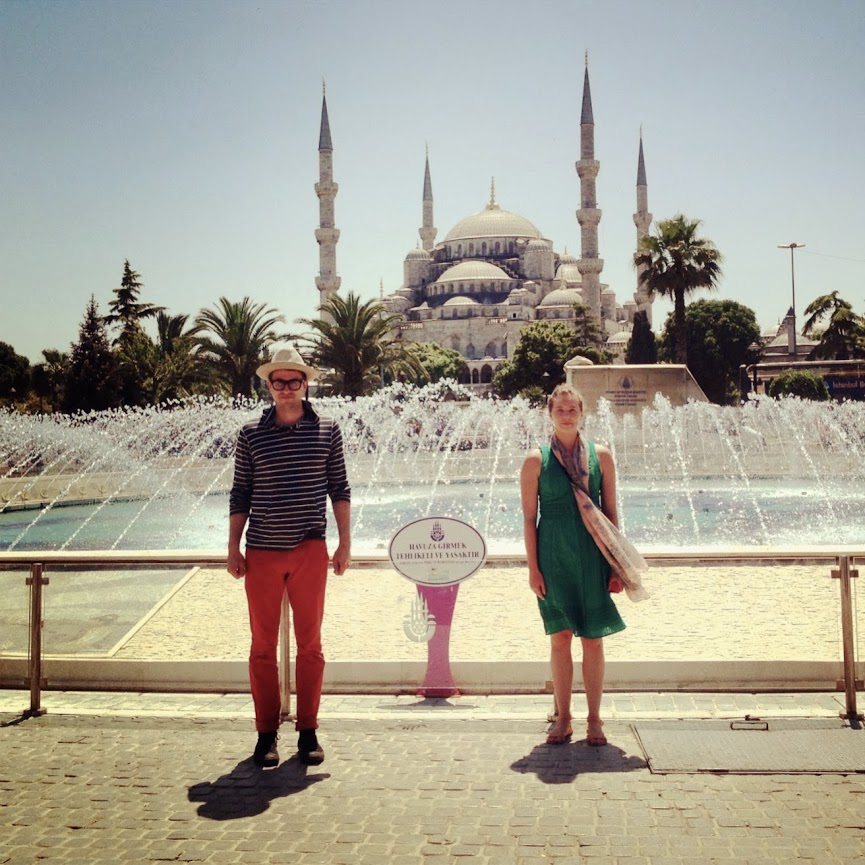
4) You mention in the article that you took nothing more than the clothes on your back, and few items that you could fit in a shoulder purse. How, beside the obvious hygienic implications, do you think travel differs when traveling with so little? Is it akin to living a minimalist lifestyle back home, or does it differ somehow because you’re on the road?
I was expecting ultra-minimalist travel to be much more difficult than it actually was. There was very little I missed about past travels with heavy backpacks and unwieldy suitcases. You really don’t need much. If traveling light differs in any significant way, it’s in the freedom of movement that it offers. I had never experienced that kind of lightness before.
Even though our story blew up because of the OkCupid angle, my original intent in traveling with so little was to explore my relationship with “stuff.” Some commenters have pointed out that millions of people in the world live with very few belongings and it was no big achievement for us to have gone luggage-less for a few weeks. That is a completely valid point and we wouldn’t deny it. Still, as an American living in a culture that places a high value on consumption and accumulating stuff, it felt personally meaningful to explore my dependency on physical belongings within the context of travel.
When I came back to Texas, I ended up giving away a lot of my belongings and about 3/4 of my wardrobe. My space feels so much more open and relaxed. I don’t miss any of it. So, yes, I think there are some crossovers between minimalist travel and minimalist living, at least based on my experience.
5) Beside having to keep in mind that the only clean clothes you were going to get to wear were the ones you were going to have to wash by hand, what were some of the practical implications of traveling so lightly? For example, the first thing that comes to my mind is having backups of certain items in case they get lost (credit card, contact lenses, memory card for my camera). Did you have any problems in this respect, and if not, was it just dumb luck, or were they problems that could have easily been overcome?
Like I said in the article, Jeff and I are both experienced travelers and even though the whole scenario appeared to be risky, we actually went out of our way to reduce the risk. We had copies of our important documents and phone numbers in secure online storage in case anything was stolen (it wasn’t). I had a backup pair of glasses in case my contacts were ruined. The only cameras we had were our iPhones, so there were no backups to worry about — everything uploaded to the cloud. We Couchsurfed and stayed with friends the entire way (only 3 of the 21 nights were spent in a hostel or hotel), so if we had run into trouble, we would have had a lot of troubleshooting support. The only thing we really wished we had brought was a tube of toothpaste (we broke down and bought some Crest in Athens).
Jeff and I agreed that we were willing to lose even the essentials that we brought with us. Travel always holds the possibility for the unexpected and that’s part of the fun. We also agreed that if we totally hated having no stuff, then we would just shift our plans and buy a cheap backpack. We’re not into suffering. It was originally just a fun, personal experiment that was designed to test our boundaries.
6) Lastly, be honest, there’s only so much cleanliness one can exude in the same set of clothes they have worn after three weeks traveling. Did you or Jeff have a certain Deadhead-like aroma about you come the end of the trip? Who held up best in the smell category, you or Jeff?
Surprisingly, no! There was only one instance of sub-grade hygiene. We took a 23-hour bus ride from Athens to Budapest and we smelled terrible by the end of it — greasy hair, unbrushed teeth and dirty feet, but I challenge anyone (even someone with seven suitcases of freshly pressed clothes), to smell like roses after that long of a journey!
We washed just as often as in the United States, which means I showered regularly and washed my dress every other day or so. I had a spare pair of underwear — Jeff didn’t. We also had deodorant, so honestly, we both smelled like fresh-cut lavender most of the time. Even when we’re not traveling I tend to take hygiene a little more seriously than Jeff, so I guess I win the smell category award (but not by all that much).
I will say this: I haven’t worn the green dress since the last day of the experiment. It’s hanging in my closet as the only souvenir I brought back from the trip.
*
Finally, to answer the most pressing question: yes, she and Jeff are still very much together. In fact, they’re planning a second adventure to South America over Christmas break.
By Matt Stabile

ABOUT THE AUTHOR
 Matt Stabile is the founder and Editor-in-Chief of TheExpeditioner.com. You can read his writings, watch his travel videos, purchase the book he co-edited or contact him via email at any time at TheExpeditioner.com. (@TheExpeditioner)
Matt Stabile is the founder and Editor-in-Chief of TheExpeditioner.com. You can read his writings, watch his travel videos, purchase the book he co-edited or contact him via email at any time at TheExpeditioner.com. (@TheExpeditioner)
The post 6 Questions For The Girl From “The Craziest OkCupid Date Ever” appeared first on The Expeditioner Travel Site.
]]>The post All The World In A Mango Tree In India appeared first on The Expeditioner Travel Site.
]]>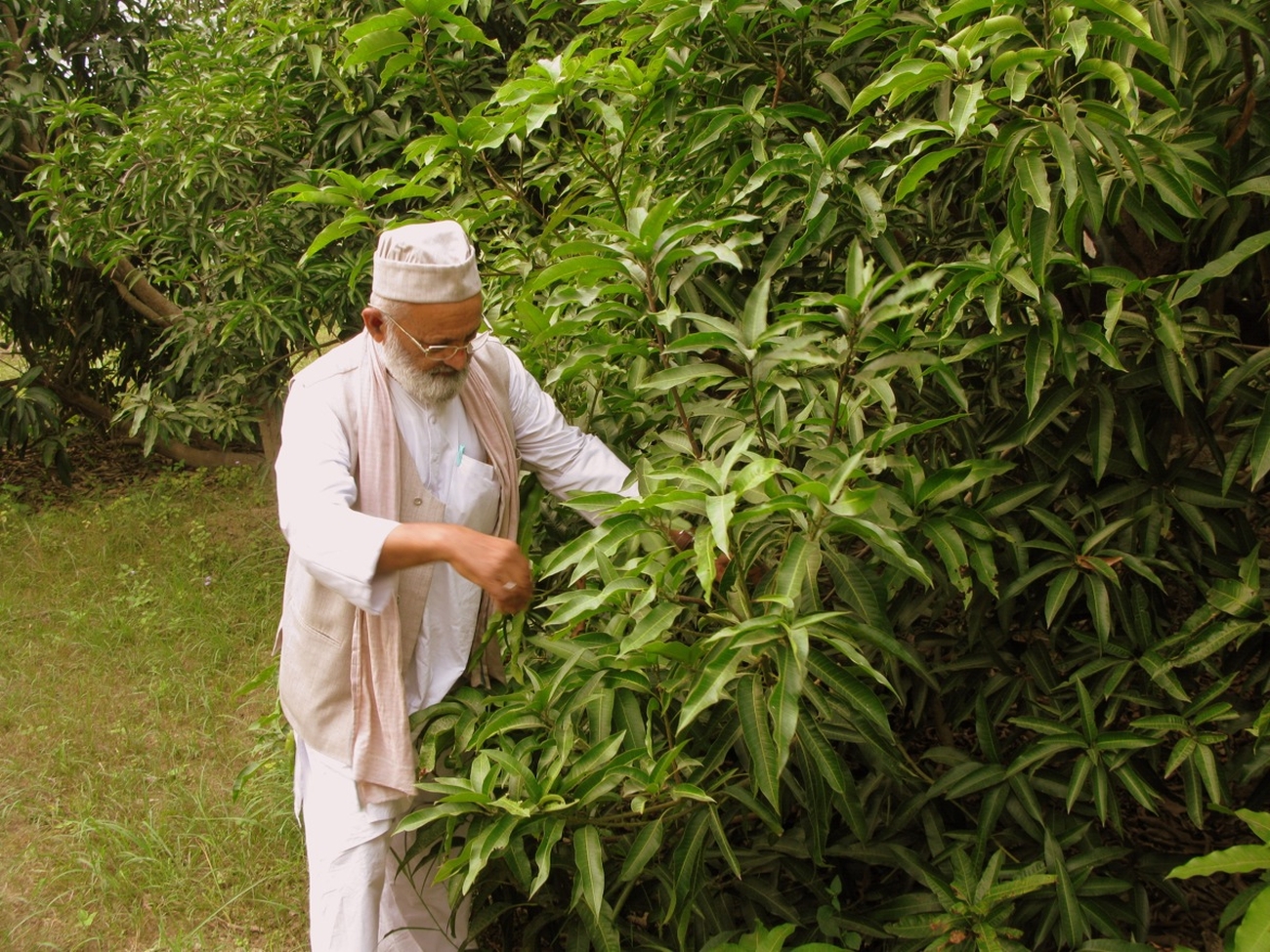
Padmashri Kaleemullah Khan has produced a living masterpiece: a strange monster of a mango tree. When I visited the man and the tree, I discovered that there was, in this curious demonstration of skill and patience, a metaphor for the entire nation of India. In a single tree, there is an entire world.
Just a short bus ride out of Lucknow, the town of Malihabad is famous for its mango orchards. This so-sweet fruit, which grows in hundreds of varieties, is one of India’s most famous products. Grown now throughout the tropics, it is native to the Indian subcontinent and has been cultivated since ancient times. Some mangos are perfect for juicing, yet others are perfect for slicing. For one variety, the recommended way to enjoy it is to pulp it within its skin, roll it between your hands and then pierce it with a straw to drink the syrupy nectar. At market bazaars and plazas throughout India, mangos are available, diced and salted with salt and spices. Sticky, sweet, inexpensive and delightful, it is the king of fruits and the most beloved of desserts.
In Hindi aam means mango. But the same word also means “common,” or “in general.” There is a modern colloquial phrase aam aadmi, or literally, “mango man.” By this, the common man is meant as the average joe or the regular bloke. Of course, everyone worldwide knows that they are average (or at least, above average), thus we are all aam aadmi.
The fertile soil of the Ganges plain and the insistent sunlight of Uttar Pradesh combine with a long history of agriculture and experimentation in Malihabad’s orchards. The weirdest experiment of all must be Kaleemullah-ji’s masterpiece tree. Fame and renown have come to him for combining, in a single tree stem, more than 300 flavors of mango.
I left the casual comfort of the Lucknow Homestay early in the morning and walked past Chief Minister Mayawati’s sprawling compound, which dwarfed the smaller residences surrounding it. On the main road I flagged down a bike-wallah. As a passenger on a cycle rickshaw, I passed the crowded roundabouts and busy street traffic of Lucknow towards the bus stand. The hot vinyl seat was tilted forward and it was with precarious balance and tightly gripped fingers that I kept from tumbling forward onto the rickshaw-wallah. He successfully dodged the motor vehicles, traffic lights and pedestrians, and came to a sudden halt in a queue of rickshaws at the bus stand. I stumbled into the shade of the open-walled structure.
It was, at first glance, a swirl of humanity. It was not too dissimilar to other Indian bus stands and felt somehow familiar. There were food vendors: small stalls selling hot, deep-fried food, stale nuts packaged in flimsy plastic or, blessedly, fresh fruit from the subtropical fields. With steel kerosene stoves roaring beneath blackened steel pots, there were chai-wallahs mixing carefully measured portions of spices and tea in a generously sugared broth of milk. There were also personal-care shops displaying cosmetics and plastic trinkets, and telephone shops selling electronics and phone credits.
Passengers waited on metal benches and chairs that were well polished from the clothes of those who had sat there before. Their luggage was piled around — zipped, bundled or cloth-wrapped. In simple uniforms of khaki, the government bus drivers could be seen milling about and refreshing after their long rides. In more elaborate uniforms of similar fabric, police officers walked through, but it was their wooden staves that seemed to command the most respect. Voices, car horns, music and the growl of engines all vied for dominance in the air.
For all of the distraction and activity, there was a clear logic to the place. Just beyond, buses were ranked, with handwritten destination signs in Devnagiri script placed in the front window. There were scheduled government buses for which the timetable was posted on the wall. Advance tickets for these were available from a deliberately calm ticket-wallah at the front of a long queue. One must attach themselves at the back end of these queues and then jealously guard their position in the order. There were also sometimes-scheduled private buses, for which timings you simply had to ask around for. Tickets for these were sometimes available from a satellite counter.
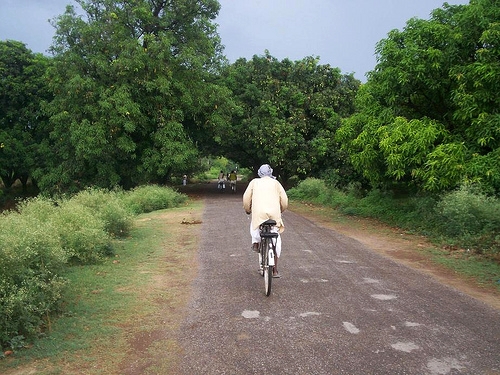
On the bus to Malihabad, I slipped through the standing passengers towards the front. The driver was only too happy to be distracted by my strangely accented inquiries. The passengers were all familiar with Kaleemullah’s orchard and beamed with excitement that I would be travelling out of Lucknow for such a curious mission. It was on the road in interactions like these, halting and awkward, that I practiced my newly learned Hindi, explaining that this orchard, and this tree, were worth travelling all the way from America for.
Once we escaped the urban sprawl of the ancient city, I could glimpse grain fields and mango orchards behind the roadside tree plantings of jamun and eucalyptus. Just before we arrived to town the bus lurched to a halt and I hopped off on the side of the highway. With a yell and a wave, I bid farewell to the driver and passengers who continued on their way with smiles at the job accomplished.
I crossed the road and was at the gates of Kaleemullah’s orchard. Though I had not called ahead, I suspect that the speed of rumor had surpassed me and that someone had texted or called. I entered and, not knowing what to expect, cautiously hollered an English “hello.” I was promptly greeted by a grey-bearded man, dressed in the white skullcap and tailored cloths of the Lucknavian Muslim Padmashri Kaleemullah Khan. A young man in a tailored uniform, who beamed a winning, natural smile at me, accompanied him. We were soon sitting drinking tea on plastic chairs next to a large toolshed. I explained, easily enough, that I had come to learn about his mango masterpiece.
To be precise, we were not speaking Hindi but its Persianized form, Urdu. My hosts were my first introduction to the famous sophistication and genteel elegance of Lucknavian Muslim traditions. Like Delhi, the city had a long history of elite culture and intellectualism, but unlike Delhi, there had been less of an exodus towards Pakistan in the time of Partition. While I had made several friends within the city, it was on this visit to Kaleemullah and his assistant that I learned to slow down, observe and partake in the ancient formalities. It was, of course, the same graciousness and hospitality that humans share throughout the world, but there is something comfortingly confident about the politeness of a senior Urdu gentleman.
Padmashri Kaleemullah produced a thick binder of photographs, articles and awards. He had collected several accolades and prizes for his mango cultivation, and his famous tree had been profiled by a handful of journalists before myself. His honorific title, Padamshri, meant a great deal; I believe it was sign of high-level government recognition. We flipped through the pictures and did our best to bridge our language divide. When we reached the final page of the binder, it was obvious what to do next. Eagerly, and with visible satisfaction, he led me down a narrow path to show me the masterpiece. As we pushed past the dark leaves of the growing mango trees, I marveled at the joy and pride people gained from such a simple pilgrimage.
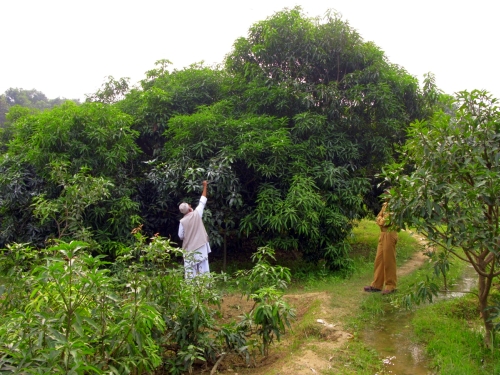
Patiently, Kaleemullah had tracked down every variety of mango he could find — every flavor, shape and color. On a single stem he had grafted branches from more than 300 separate lineages of mango, a singular accomplishment. It was to this stem that he led me, and as we approached a short but sprawling tree, I could see that it was both strange and curious.
Most trees have a unity of form, color and texture to their leaves. You can immediately recognize the pattern that underlies its visual appearance and its actual structure. There is a self-referencing integrity, but this tree was a fused patchwork of different colors; its very existence was an education in detecting subtle variations. In one portion of its crown the leaves were held upright, yet in another they were even. In another place, glossy yellowish leaves grew, and in another, dark dull green leaves were there. Some sections were just beginning flower buds and some were flowering in full bloom. There was, unfortunately, none fruiting at the time of my visit.
We entered into the shadowed canopy of the tree. The stem was remarkably slender and there were very few interior branches. In this enclosed space he showed me one of the grafting points. With hand motions he demonstrated how we would slice notched angles and then attach the orphaned cutting to this new, hybrid tree. It seemed tremendously simple, but I knew that there was a fine art to the timing and tending of the grafts.
Inside this tree I was struck by the variety surrounding us. It was like a sky full of constellations, or like a land filled with diversity and contrast. In slow and clumsy Urdu I spoke to Kaleemullah about the whole world in a mango tree — aam mein, duniya — “mango in, world is.”
Like the vast country around us, there was flavor and spice, sweetness and sour. And, like the world around us, there were many different types, all linked to the same stem. It was a simple observation and, fortunately, a simple phrase to put together. Padmashi Kaleemullah and I — our rapport built quickly around a shared enthusiasm for the mango tree –were both aam aadmi. Aam mein, duniya hai.
By YD Bar-Ness

About the Author
 YD Bar-Ness is an outreach and conservation ecologist based in the far corner of Australasia on the island of Tasmania. He is on a long-term mission searching for the Kalpavriksh, the mythical wish-fulfilling tree of ancient Sanskritic myth. He hasn’t found it yet, but will make sure to tell you when he does. He’s online at Outreachecology.com and TasmanianGeographic.com.
YD Bar-Ness is an outreach and conservation ecologist based in the far corner of Australasia on the island of Tasmania. He is on a long-term mission searching for the Kalpavriksh, the mythical wish-fulfilling tree of ancient Sanskritic myth. He hasn’t found it yet, but will make sure to tell you when he does. He’s online at Outreachecology.com and TasmanianGeographic.com.
The post All The World In A Mango Tree In India appeared first on The Expeditioner Travel Site.
]]>The post Turning The Car Around: One Road To Expatriatism appeared first on The Expeditioner Travel Site.
]]>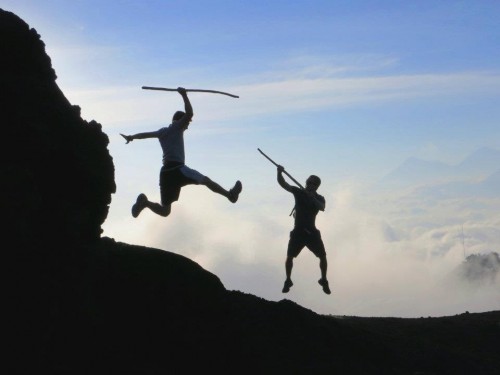
Stories can be told from limitless angles of perspective. So let’s begin this tale from the viewpoint of a Salvadorian family living in a small, rural village. It is a sunshiny day in a one-goat town a few hours drive and world away from the busy capital — a place far removed from the beaches and bars where gringos tend to roam. The day begins no different as previous days, weeks and months. A young couple with a four-year-old son and eight-year-old daughter tend their one-room store across the street from their home. One of their more valuable possessions, a female goat, is tied in front of their store.
Then comes a moment that will lead to a story that their children will retell to their friends at school, mother will recount at family fiestas and the father will tell his soccer buddies, that — sí, no les miento — this really happened. An ’88 Volkswagen Jetta pulls up to the front of their store. Inside are three road-rugged gringos, a puppy and a baby goat.
The gringos get out and begin to chat in shaky Spanish with the family. Pleasantries, smiles and nods are exchanged. Then the gringos huddle and converse amongst themselves in English and come to an agreement. They go to the car, fetch the goat and present it to the now elated family as a gift. This day has taken a unforeseen turn that no previous day, and let’s be real, no subsequent day, is likely to take.
They way stories in the village are swapped and embellished with each telling, we can only guess 10 years from now how the “gringo goat story” will be told: They were gringos — seven feet tall — having just returned from rescuing the goat from a burning barn where every man, woman, child — but not the goat — was killed, so they came to our village and gave us the sole surviving goat.
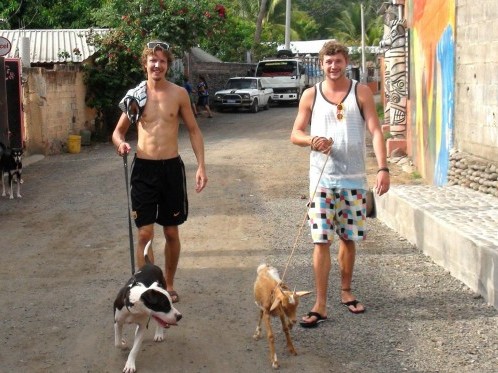
Actually, the goat was a gift for Derek Girard on his 26th birthday. Since he was a kid, Derek had an obsession with goats. To this day, goats are his favorite animal and he loves them with the passion that Miley likes controversially shaking it. He and his younger brother Dustin have had the tradition of one-upping each other on their birthday. Derek will have troubling one-upping the goat (Dustin’s favorite animal is an elephant).
Getting the goat was no easy task. Dustin and friend Dan Pangman spent five hours in the Salvadorian countryside searching for one that was for sale. The process might have been shorter, but prior to El Salvador, the trio had spent time learning Spanish in Mexico, where word for goat, chiva, in Salvador means, cow.
USD$20 and a language lesson later, they had a baby goat, which “shit all over the hostel and ate the garden.” The goat joined the rag-tag trio and took long walks on the beach with them and their 4-month-old puppy in the surf town of El Tunco, El Salvador, before reluctantly, and with heavy hearts, they realized that the goat needed a family; one with a mother and father whose M.O. didn’t consist of smuggling the goat — who couldn’t stand to be away from the trio — into hostels.
Let’s Back Up a Bit Further In the Story
Dan and Derek met when they were both hired by marketing firm JTI, a company which throws massive parties. Part of their “research” consisted of being flown to Toronto to party in exclusive VIP areas of bars and club. Their research paid off. The party they threw in Vancouver was voted the best party in Canada, which netted them a free trip to Miami (is anyone jealous yet?), where they were ushered into a Miami Dolphins games, and onto exclusive yachts for more, yes, partying.
It turned out the pair had more in common than knowing how to throw a killer party: both had spent three months volunteering in Tanzania, an experience that had stayed with them. Though they were having the kind of fun we must imagine two guys in their twenties must have been having working to throw parties, there was a tug towards something they considered bigger.
Our lives tend to plateau into daily routines, and one chance meeting, one conversation, or one decision is all it takes to shake things up and change everything. A conversation that decided their fate and set out a new course went something like this:
“I want to get out of here, quiet my job and travel,” Dan told Derek.
“Bullshit, you are,” Derek told Dan.
“Yes, I am.”
“If you are, then I’m going to do it too.”
“No, you’re not?”
The challenge was on the table and they both egged each other on enough to meet it. They put in their one month’s notice and soon they were jobless and sitting next to each other in a 1988 Jetta, with a vague plan to make it through South America. “It’s a beauty car,” Derek says with a look reserved for talking about beautiful women. “We’ve done so much off-roading in that bitch.”
Along their way they met Derek’s brother Dustin in Antigua, Guatemala, where they planned to only stay a few weeks. Derek says that it was not difficult to convince his brother to leave his North American routine life behind and join in on the adventure. After staying longer than they planned, they finally left Antigua and headed to Guatemala’s Caribbean coast where they spent three months volunteering in Rio Dulce. Derek describes it as a place where, “a cut becomes an infection in a second and you fall apart pretty quick.”
So again, they came back to Antigua to recharge their batteries, planned to stay a couple weeks but stayed a couple months before they were back on the road. They made it as far as Panama. There they were supposed to ferry their car across the canal and continue their travels on a fresh continent, but they felt a tug of having left something behind.
“Antigua had our heart,” Dan says, “We needed to go back.”
As expats in Antigua know, that’s the story of how many a two-week tripper turned into an Antigua Expatriate. Of the countless places they stopped off across the thousands of miles of their journey, it was Antigua, that magical “fairy-tale city” in the highlands, that felt like home.
In their previous stays, they had helped friends, Carlos and Carolina, throw a successful party at their corner bar Porque No, and after juggling around dozens of ideas about what they would do, they decided to “stick with what [they] knew” and open a hip-hop bar. Their goal had been from the beginning to use their talents to give back, to volunteer their time and support efforts, and they saw their vision for their bar as supporting that.
“You have to support your life at some point,” Dan says, “We’re passionate about travel and volunteering and giving back, and this is a way to do that on an ongoing basis.” Dustin and Derek are on the same page. “Our trips were about the pay-it-forward model, giving people good vibes. The law of attraction says that when you give out positive vibes, positive vibes come back to you.”
But this is easier decided than done. In Antigua this is an uphill battle for three gringos needing to get through a pile of paperwork and licensing. Most people “in the know” around Antigua would have told three gringos barely speaking the language a sarcastic “Good luck.” But perseverance and good vibes are a powerful combination, one that can beat most odds, and after eight months of tireless work, and struggle against what some thought a pipe dream, they found themselves serving up opening night drinks.
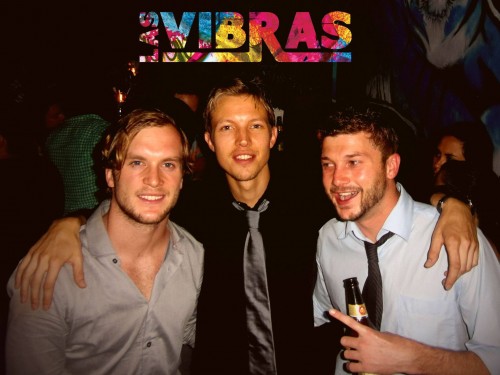
La Vibras Opens For Business
It’s opening night at La Vibras (Spanish for Vibes) and the house is full. The crowd is a dense concentration of Antigua’s heavy-hitting expatriates who have come to show their support for Derek, Dan and Dustin’s endeavor. That presence means a lot. It means they’ve carved deep inroads into the community. Upon my return to Antigua the month before, it was nearly impossible not to meet Derek, Dan and Dustin, as it seemed most everyone in town not only knew them, but also had nothing but good things to say about them.
I am walking around with a digital recorder interviewing people who are all ecstatic to be here. In the very least, everyone is excited about the free drinks from 6-8 p.m. This means by 8 p.m. I am drunk, and in good, bacchanalian company. Listening to my interviews as I write this, they crescendo with my level of imbibing. Unnecessarily aggressive interviewing fueled by joyous inebriation and rude interruptions and rambling questioning, I decide is the appropriate term for my voice I am listening to.
Everything I record after 9 p.m. is painful for me to hear, but I type out the important stuff and then delete the recordings for fear that these could fall into the wrong blackmailing hands — my interview with Derek sounds more like harassment than reporting. Upon his saying, “I believe everything happens for a reason,” I hear my voice respond, “What do you mean? Does everything happen for a reason, because some people die sad and alone?”
WTF, Luke? But the vibe of Las Vibras is one where everyone is enjoying themselves to the max. Antigua, and other such dots on the expatriate map, is a place where a vision like this can materialize when a person commits to their casual daydreaming. The consensus seems universal: Derek, Dan and Dustin are refreshing to have here, opening a kind of bar that the community was lacking: “Where sleek meets the street,” as Derek puts it.
The night began with Dan playing music, both covers and original, on his acoustic guitar, and then led to upbeat hip-hop and pop music. People are drinking, dancing and admiring the graffiti art covering every wall. Alex, a British expat in Antigua, spent three months perfecting and finishing the wall art. He painted the exit signs the day before opening night.
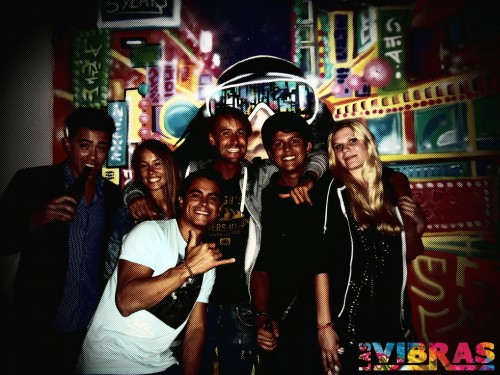
When you follow the line of cause and effect long enough, you see that all of this — the swaying revelers, the art, the music, everyone in this room — is the result of a conversation that led to a dare, which led to not backing away from a risk. Dan put it perfectly: “A risk like quitting your job, going traveling, following your dreams — it’s riskier not to take it. You can always revert back to your mainstream lifestyle, but you can’t go and live out that dream when you let it pass by.”
Derek, basking in the glow of a successful opening night thinks back to the eight months it took them to get to this point. “It’s all about positivity. Every time you get a no, it’s just a challenge. They can say no to us all we want, but we are going to continue going. They say, no no no no, and we say yes yes yes yes.”
“My life in Canada was not based on happiness,” Derek continues, “it was based on all the wrong reasons. The pressure that they put upon you in society to be successful, graduate from high school, then get a degree and a job and start working. I am going to live life for happiness. If I’m happy, I can make other people happy, and if I’m miserable, I can’t.”
No one here tonight seems miserable. There’s a special vibe in the air, and the buzz of “the new place” has yielded to a night when La Vibras opened its doors and invited the world at large to come on in and throw back a round.
On my recorder, I skip through several hours of irrelevant interviewing I conducted near the bar. It seems by 11 p.m. that I am using my microphone exclusively to try to talk to girls; only occasionally remembering to ask them about the bar. “I’m stoked,” a Peace Corps volunteer says over the sounds of music and people enjoying themselves, “tons of people, great vibes, music is good, this is great.”
And just as a goat in El Salvador found an improbable home in the countryside, it seems that Derek, Dustin and Dan have found theirs in Antigua.

About the Author
 After setting out to hitchhike from Chile to Alaska, Luke Maguire Armstrong stopped in Guatemala where he spent four years directing the social service programs of the charity Nuestros Ahijados. He is the author of iPoems for the Dolphins to Click Home About, which is especially enjoyed by people “who don’t read poetry.” His new book, How We Are Human, was recently released. (Follow Luke on Twitter: @lukespartacus)
After setting out to hitchhike from Chile to Alaska, Luke Maguire Armstrong stopped in Guatemala where he spent four years directing the social service programs of the charity Nuestros Ahijados. He is the author of iPoems for the Dolphins to Click Home About, which is especially enjoyed by people “who don’t read poetry.” His new book, How We Are Human, was recently released. (Follow Luke on Twitter: @lukespartacus)
The post Turning The Car Around: One Road To Expatriatism appeared first on The Expeditioner Travel Site.
]]>The post This Is Why I’m Not Taking My Phone To India Tomorrow appeared first on The Expeditioner Travel Site.
]]>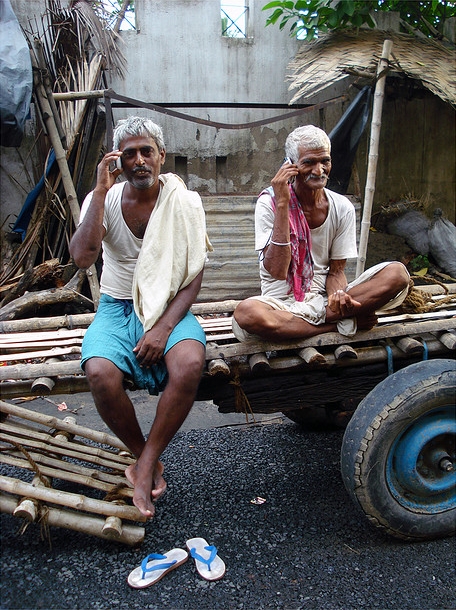
Technophobe: To Be or Not To Be
I’m leaving for India tomorrow, and one thing that I’m not packing with me is my iPhone. Yes, that very same phone that I use to take pictures with and to then upload to Twitter, Facebook and Instagram. The same phone I use to check my multiple e-mail accounts every 10 minutes or so when I’m not sitting at my computer or, gasp, out of cell range. The same phone I use to listen to my daily podcasts, check in on the news while I’m waiting in line, respond to text messages within minutes of receiving them, upload videos using Vine, check the hourly weather forecast, and to find out where I am and how to get to where I’m going using Google Maps. In other words, I’m going to attempt not to be distracted while I’m traveling.
Now don’t get me wrong, as anyone that knows me can attest, I’m the opposite of a technophobe. I was one of the first people to upgrade my phone to the iPhone 5 when it was released. I much rather text than to have to sit on the phone and carry on a normal conversation. I run this blog, which if anyone who maintains their own site knows, it’s not for the digital faint of heart. I even have a Reddit account. Suffice it to say, there’s little in the digital world I haven’t adopted — except for a couple of exceptions.
If you walk into my bedroom, you’ll notice that there are stacks of books lying around. Those are the ones I haven’t read. In my closet, stacked on top of each other next to my out-of-season clothes, are the books I’ve read (at least the ones I’ve read in the past six months or so). Take a look in the closet of my old bedroom at my parents’ house or their storage area above the garage, and you’ll find boxes and shelves full of my old books. Given that we’re several years into the e-book era, one may ask: Why would you carry on this Baroque tradition of reading text on dead trees?
It’s not because I like clutter, but it’s because I like books. Specifically, I like the experience of reading physical books rather than those on a screen. I’ve read a few books on my phone while toiling away in the subterranean depths of New York’s subway system. I had a pleasurable experience reading White Fang during a stretch of the winter of 2012, and I even re-read a free digital copy of Siddhartha on my phone last summer (as incongruous as that may seem). But even then I could tell, the experience wasn’t the same. The words didn’t sink in as well for me. The story didn’t seem to capture me as much as I was reading it. And when I was done, as odd as it sounds, the pleasure of getting to the last page and finishing the book was completely missing as I simply hit the “Home” button after finishing. Essentially, I think traveling with a phone is like reading a book on a tablet.
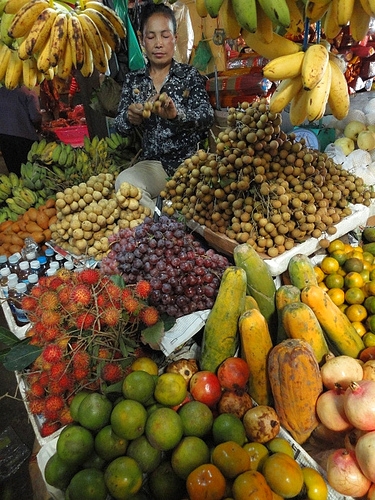
Technology Has Changed Travel the Past Five Years
Most of my international travel has occurred in the past five or so years, an odd time when phones transitioned into things that flipped into things that did everything. When I traveled to Argentina and Chile in November of 2007, bringing a phone with me didn’t even cross my mind. My Verizon Razr flip phone wouldn’t work in Mexico let alone Argentina. Besides, everyone I knew was aware I’d be traveling, so they wouldn’t bother calling or texting me. Other than that, I had my camera with me, and the hostels I stayed at all had computers. What use would I have for a phone?
As each year went by and phone technology changed, I ran into a few inconveniences by not having a phone while traveling, but nothing dire. There were the occasional instances in which I was to meet someone at some fixed location, and when I or they were running late, we couldn’t just shoot each other a text. This resulted in one of us having to wait a few extra minutes in the dark. No big deal.
I remember a time in Cartagena when I met a backpacker as I was exploring the city. We had lunch and wandered together for a bit. When we parted in the afternoon, I suggested that they meet up with me and a few friends I had made at the hostel for dinner later that night. Not knowing where we’d be going, I suggested they simply meet me in a certain square at 7 p.m. How quaint is that? A fixed meetup at a certain time, made in person no less, rather than by text or Facebook. It was like I had stepped into some sort of black-and-white travelogue featuring Ingrid Bergman and Jimmy Stewart. Today, if that happened in New York, we would’ve exchanged numbers or friended each other on Facebook. We would’ve then texted back and forth until a time and location was finally set. Then, inevitably, because we were both on phones, someone would be running late. But no worries, we would have just shot a quick text: “Runnin l8, b there in 20.” Not that that’s bad, but it’s a different experience, one that lacks the spontaneity and commitment that people felt for years.
Besides the quaint notion of predetermined meet-ups, when you travel without a phone, it’s inevitable that you become more aware of your surroundings. No longer do you fret about snapping a picture for Instagram, or about checking in on Facebook to see what other interesting things your friends are doing at that exact same time. When you’re traveling around country “X”, un-wired and un-harnessed from the digital world, a funny thing begins to happen: You suddenly find yourself actually there. You take in your surroundings without distractions. The smells become more pungent, the sounds become clearer and the experience of being there becomes actually real rather than a digital abstraction.
A Scientific American study revealed that even small digital distractions (those lasting less than 3 seconds) can significantly affect your focus and memory. Just as in having to enter a random string of letters while in the middle of an unrelated task (as what occurred in the study), constantly checking your e-mails or updating your status or snapping a picture can severely impact your experience while traveling.
Think about it: Recall all those thoughts you had while walking in a crowded market in a foreign country. What type of fruit is that? I wonder where the seller is from? How is it that this market exists here whereas a supermarket would’ve replaced this if we were one country over? What would it had meant if I had been born here? These strings of thought come naturally, and they often come in sequence to one another. To interrupt these thoughts with your phone would act as an artificial braking system to your own thought consciousness, and even worse, would impact the memories you have after you leave.
Am I Really “Going off the Grid”?
That’s all find and good Matt, but don’t you spend an inordinate amount of time wandering around a city taking video of yourself talking to the camera and shooting B-roll for your travel videos? Isn’t that just the very technical distraction that you’re speaking of? Yes, it’s true, I don’t exactly go Robinson Crusoe when I travel. I have a pretty good camera I picked up a couple years ago, and I use it often to take pictures and video probably much more than the average traveler.
I really like taking pictures, and I like doing video even more. And yes, there are plenty of times that I waste a good amount time in some incredibly scenic spot overlooking an ancient Mayan temple or wandering a little-visited food market fidgeting with my camera and setting up shots of myself pretending to nonchalantly take in the beauty around me. But like I said, I am wrapped up in this tech world to a certain degree, and travel pictures and video is a very important part of this. However, I am at least aware of these distractions. Therefore, whenever I travel, I am sure to at least put some time aside (usually at night) where I decide to leave the camera home and I will not worry about missing a certain shot while I’m out and about. You can’t document everything, and even if you could, you shouldn’t.
Second, I can justify some use of this technology by the fact that it has often enabled me to explore and see more than what I normally would have. Creating travel video has allowed me to interview an archivist at the Guinness Factory in Dublin, explore parts of Montreal that I had missed before, and even wake up early after a rough night out in Quebec City to explore its Old Town — something I probably would’ve skipped if not for the internal pressure to get that segment of my video.
In other words, knowing that I will be distracted by technology, I make sure that that the technology will at least be an enabler and a facilitator of experiences, rather than the opposite. It doesn’t always work out that way, but I at least try.
So, yes, it’s guaranteed that I will get lost much more often since I will not have Google Maps in my palm to help guide my way. I will likely have more difficulty meeting up with new friends I make along the way, and I will miss out on responding to some e-mails right away, but I’m fine with that. It’s in those experiences — being forced to ask a stranger for directions, mistakenly wandering into a neighborhood that you otherwise would have missed, spending time exploring rather than e-mailing — when those true travel experiences occur.
For those of you interested, I will be live-Tweeting my trip here: @TheExpeditioner, and updating TheExpeditioner.com with pictures and video along the way. Just don’t expect them to be timely — I’ll have to wait until I’m back in my room on my computer to post anything. My phone will be turned off and at home.
By Matt Stabile
[India Phone by Dipanker Dutta/Flickr]

ABOUT THE AUTHOR
 Matt Stabile is the Founder and Editor-in-Chief of The Expeditioner. The Expeditioner began in 2008 and is headquartered in New York City. You can read his writings, watch his travel videos or contact him at any time at TheExpeditioner.com. (@TheExpeditioner)
Matt Stabile is the Founder and Editor-in-Chief of The Expeditioner. The Expeditioner began in 2008 and is headquartered in New York City. You can read his writings, watch his travel videos or contact him at any time at TheExpeditioner.com. (@TheExpeditioner)
The post This Is Why I’m Not Taking My Phone To India Tomorrow appeared first on The Expeditioner Travel Site.
]]>The post Living In The Face Of South Africa’s Apartheid appeared first on The Expeditioner Travel Site.
]]>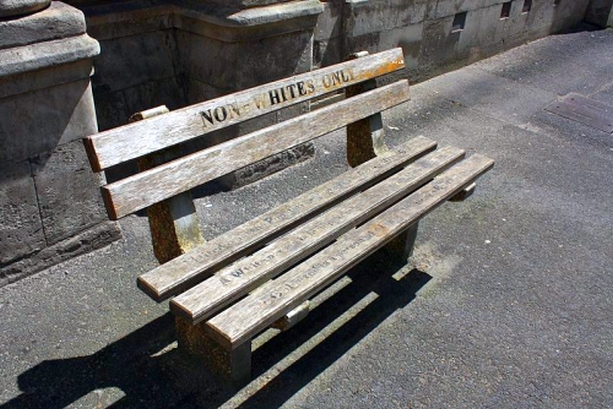
After two weeks in the bounty of Cape Town, South Africa, I can safely say I’ve arrived home.
The depths of jet-lag got me out of bed just before dawn. I’ve fired up my laptop and I find myself typing amidst a flickering orange hue of a fire to my right; my two huskies lying at my feet. If I crane my neck enough, I can see dawn chasing off the blanket of sub-zero night, just enough to backlight the jagged profile of Montana’s Tobacco Root Mountains. If I lived anywhere else, I probably wouldn’t unpack my bags.
My fingers seem to take on a life of their own, dancing across the keyboard as if they were talking to me, rather than me creating words with my fingers: “Travel is the only thing you buy that makes you richer.”
It seems as if my fingers possess a deeper knowledge of life than I do. Who knew?
When I read that quote, again and again, it begins to sink in. Traveling is sometimes reduced to ticking off destinations, getting stamps in your passport, obtaining trophies; even conquests to bring home and brag to others. To me, this defeats the entire reason to travel. To travel is to experience the world, to learn about the world and the many people we share it with. As a result — one can only hope — we learn about ourselves in the process.
These previous two weeks have been an outpouring of love and generosity from friends I thought I would never see again. In 2009, I left Korea when my teaching contract was finished. It also meant I was leaving those I had grown close to in my time there. It’s a common plight of ESL teachers and travelers alike. However, three years later, I found myself sleeping in their Cape Town loft, reunited.
This trip’s worth cannot be measured by mileage, souvenirs purchased or seeing those guidebook “must-see” sites. The value is found in the moments. The split-seconds when your heart flutters, when you’re overcome by thankfulness, the pang of insight, or when you connect with someone unexpectedly. Any trip, then, becomes memory grounded in whisps of lingering moments. It will be a fleeting fraction of real time that electrifies your cortex, returning you to the place and moment. The taste in your mouth becomes the revered wretchedness of three-year-old kimchi, the hardened earth under your feet is now flour-soft Boracay sand, or the feel of shade on a hot day takes you outside the former Race Classification Appeal Board building on Queen Victoria Street in Cape Town.

Cape Town is one of the few cities on earth founded by a company, rather than “discovered” and claimed by a country. The Dutch East India Company established the colony as a refueling point along the sailing route around the southern tip of Africa. Cape Town started as a large scale farm — the Company Gardens — which restocked the ships docked in the waters of Table Bay. Soon, the company began enslaving people from Indonesia and Madagascar to meet the demand of the quickly growing colony. Slavery was established.
Of course, I didn’t know any of that before taking an impromptu walking tour of downtown Cape Town. Generally speaking, a walking tour of a town, any town, won’t be one of those incredible, awe-inspiring stories that transports you back decades later. Lucky for us, a good friend of our hosts, a successful guide in his own right, volunteered a day of his weekend to show us around. It was a wonderful gift. From the Castle of Good Hope to District Six, we heard the good, the bad and the heartbreaking events that occurred within a few square blocks of downtown.
We strolled passed a brightly painted Dutch-style building, one of the oldest in Cape Town, now the Iziko Slave Lodge. The building is a museum that exposes its original purpose: housing slaves before they were to be sold.
Down the block from the slave lodge stands a rather ordinary stone building. Bookended by generic ’70s modular architecture, the building gave off a former-governmental-structure vibe. Any other day I would have wandered right on by without giving a whisper of thought. On this day, that building became the moment.
The grey blocks making up the exterior were shaded and weathered, just another old building blending in with modern city life. We stopped in front of it, next to a bench and nearby plaque. I began to read:
In the 1960’s, a room in this building was the scene of formal hearings of the most bizarre and humiliating kind as ordinary people came before an appeal panel to argue about what “race” they should be labeled. Between 1950 and 1991, apartheid’s Population Registration Act classified every South African as belonging to one of seven”races” — and accordingly granted or denied them citizenship rights on a sliding scale from White (full rights) to Bantu (with the fewest). The classification was subjective and families were split apart when paler or darker skinned children or parents or those with curlier hair, or different features were placed in separate categories.
I looked closer at the bench and brushed away some dust: Whites Only. Perhaps six feet away, on the other side of the building’s entrance, was another bench: Non-Whites Only. Apartheid suddenly blindsided me; a heavy weight on my chest. It became real.
I could tell my wife’s realization, similar to mine. We looked at each other, our skin extra pale from the northern hemisphere winter, then to the group — all with deep-hued skin tones. It was just 21 years ago that we would have been forced to sit apart; forced to live separately. The quiet of realization rang like a gong inside my head. This was their life. Aside from their accents and superior style of clothes, the difference in our skin color hadn’t even entered my mind until now.
The moment.
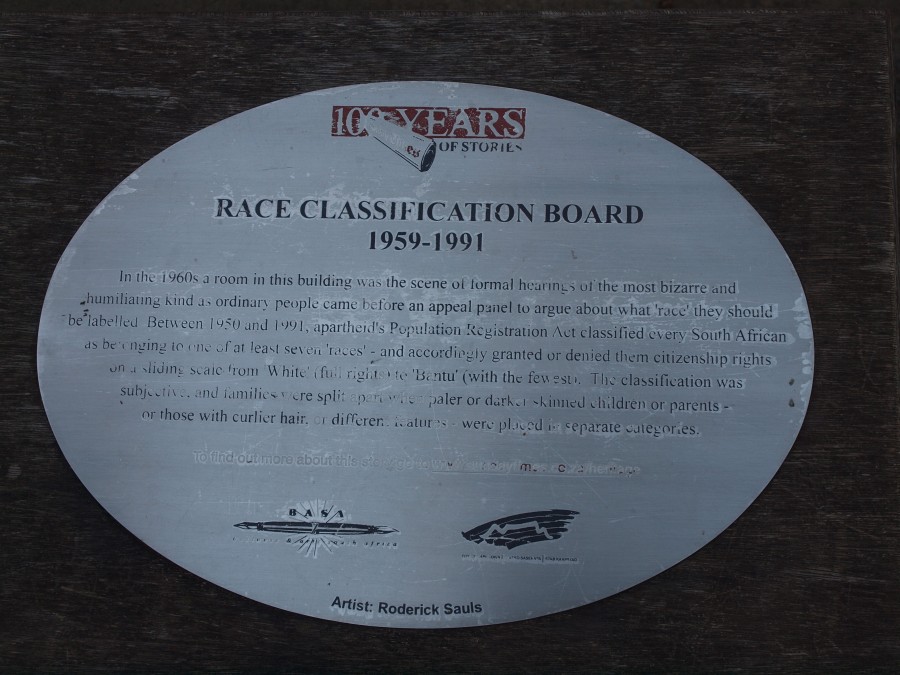
Apartheid was the official policy of racial segregation practiced by South Africa’s government that included rigid political, legal and economic discrimination against non-whites. This officially came to an end in 1992, a mere 21 years ago. This discrimination has touched everyone I shared the sidewalk with. It has touched our friends’ lives. In many ways, this still is our lives.
I attempted to wrap my mind around it: If, by chance, I had met these people I have come to love while we were in junior high school, it couldn’t have happened — wouldn’t have happened. How have such generous, giving and thoughtful people escaped such evil to become beacons of light. Why don’t they hate me? The only possible answer is love and kindness. Sharing of love and kindness is more powerful than anything in the world.
My heart broke, and still does, for an entire people. Yet, simultaneously, I am comforted that our world, for the most part, is heading in a better direction.
I can easily say life would not be nearly as rich nor as beautiful without my Cape Town family. For two weeks, everyone there gave us so much of themselves, their time and their grace. They invited us into their homes, cooked and shared stories. Our friends are love, they are all that is good within the Rainbow Country.
Yes, we are different and that’s okay. In fact, that’s great. It makes the rainbow all that more beautiful. I really am the richest person in the world.
By Jon Wick
[Non-Whites Only Bench by KNewman1/Wikipedia]

About the Author
 Jon lives in Butte, Montana, teaching in the Technical Communication department of Montana Tech and moonlighting as the owner of 5518 Designs. Between work, play, and his recent adventure into roasting coffee, Jon squeezes in family time on the trails with his wife Cassie and pair of huskies. Catch more of Jon at TheJonWickProject.wordpress.com. (@ExpedJon)
Jon lives in Butte, Montana, teaching in the Technical Communication department of Montana Tech and moonlighting as the owner of 5518 Designs. Between work, play, and his recent adventure into roasting coffee, Jon squeezes in family time on the trails with his wife Cassie and pair of huskies. Catch more of Jon at TheJonWickProject.wordpress.com. (@ExpedJon)
The post Living In The Face Of South Africa’s Apartheid appeared first on The Expeditioner Travel Site.
]]>The post 10 Places You Will Never Visit: A Challenge? appeared first on The Expeditioner Travel Site.
]]>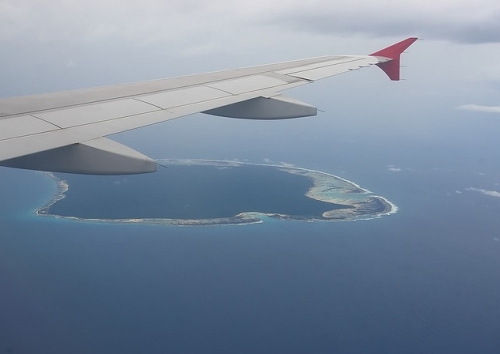
I burned my hand pretty bad when I was at an age when I was longer dirtying my diaper but still believed that the Easter Bunny sometimes went on picnics with Santa Claus and Batman. I scorched it while helping my mom cook in the kitchen (if I was a girl she would have named me Kelly). She removed a skillet from a red-hot burner and warned, “Don’t touch that.” I immediately put my hand down on the burner and then screamed like the little Kelly girl that I wasn’t.
My mom’s question was reasonable: “Why would you immediately touch that after I just told you not to?” But she was not able to deliver that particular lecture to me as she had the classic situation of a burned child on her hand.
My family still tells the story as the earliest example of my deep-seeded desire to do immediately what I have been told not to do. It’s why when I read the headline in The Sydney Morning Herald, “Secret Spots: 10 places you will never visit,” that I felt resentment even before I read the first word. My editor here only allows me to swear when I do it artfully, so you’ll just have to believe that my gut reaction to this headline was not “Truck Hat.”
The 10 secret spots include an island that has one deathly venomous snake for every meter of island, one that is home to a secret stash of some French guy’s $10 billion art collection, another island that is inhabited by hunter-gatherers who send a hail of arrows at any outsider stepping upon their beach, and a secret weapon testing range the size of England. Perhaps the most forbidden is the Queen of England’s bedroom, with all of the lusty longing that goes with imagining what it must be like. Back in the day, we can only imagine what sort of bacchanalian fun was to be had there.
The article’s list of ten places you’ll never visit is just an appetizer. In fact, the author has a whole book of 100 places he thinks no one reading it will ever go, which, without having read, I already resent with the fervor that I begrudge reality for having never put Jewel and me in the same bar on the same night. I am not saying she would definitely want to date me, just that it is very likely until this scenario has the opportunity to be proven wrong.
While I might be one of the few that takes the feeling of wanting to break out of the boxes the world places us into to the point of blackening my hand, I suspect I am not only the only one here who spells travel with a capital “T” and who sees this list as more challenge than caution. The jump from placing your finger on a spinning globe to deplaning somewhere that prior to that hour had always been far away is an open declaration of war against a world that limits the ability of dreams to incarnate.
If I learned anything from the burning-of-the-hand incident, it is that I have learned not to take people’s word and not doing something just because someone or everyone says that something cannot be done. The negative result of this way of living is that sometimes you literally get burned. The upshot is you find yourself spending less time dreaming and more time actually doing.
The above-mentioned list and book can be read in two lights. One, the light of acceptance, or two, the acknowledgement that while he’s likely right that we will never get to these places, imagine what we would do if we did.
[Secret Spots: 10 Places You Will Never Visit via The Sydney Morning Herald]

About the Author
 After setting out to hitchhike from Chile to Alaska, Luke Maguire Armstrong stopped in Guatemala where he spent four years directing the social service programs of the charity Nuestros Ahijados. He is the author of, iPoems for the Dolphins to Click Home About (available for sale on Amazon.com) which is especially enjoyed by people “who don’t read poetry.” (Follow Luke on Twitter: @lukespartacus). His new book, How We Are Human, was recently released.
After setting out to hitchhike from Chile to Alaska, Luke Maguire Armstrong stopped in Guatemala where he spent four years directing the social service programs of the charity Nuestros Ahijados. He is the author of, iPoems for the Dolphins to Click Home About (available for sale on Amazon.com) which is especially enjoyed by people “who don’t read poetry.” (Follow Luke on Twitter: @lukespartacus). His new book, How We Are Human, was recently released.
The post 10 Places You Will Never Visit: A Challenge? appeared first on The Expeditioner Travel Site.
]]>The post Is There A Right Path To Travel? appeared first on The Expeditioner Travel Site.
]]>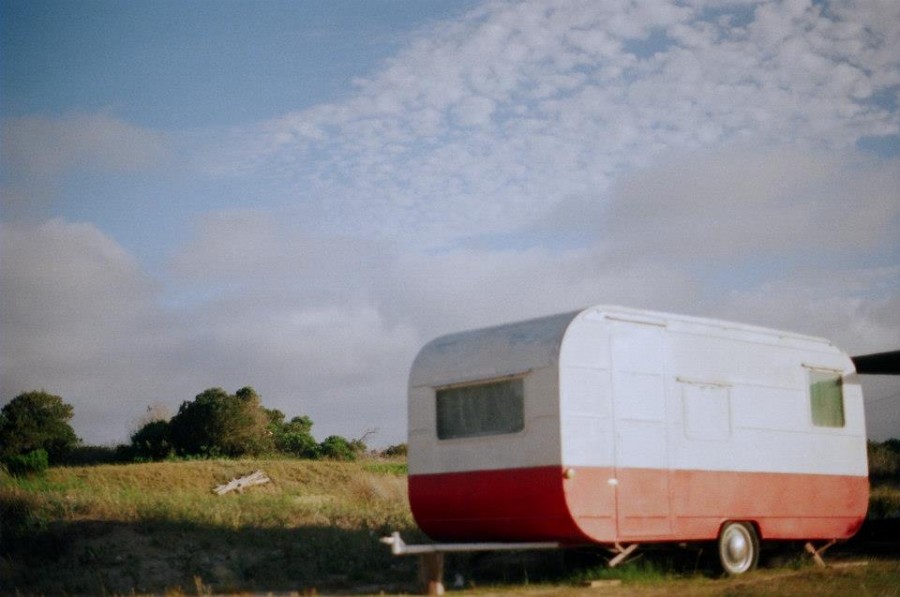
And, I quote, “Getting there is half the fun when you’re on a cruise ship that left Brisbane on Saturday afternoon and won’t dock at Noumea until Tuesday afternoon, and you’ve got four new books from the library.”
That was from a recent article in The New Zealand Herald by Ewan McDonald who head-butts the idea of traveling for the journey as opposed to the destination-centric approach. But, wait, wait, it’s a little more complex, the author ponders. The fun part of travel, he says, is the luxury that we get to enjoy: those four days of worn-in sun chairs on the deck of a cruise ship. Rejuvenation that comes from choosing a little R&R instead of the rum and coke with the locals while stranded in some abandoned nowheresville hut. To McDonald, “roughing it” is not the kind of travel people are actually looking for.
I agree that travel remains largely for the temporary adventurist, those that have a few weeks off here and there and need some fresh ideas from the hooligans abroad. However, I would hate to lump travel into just one category. Generally, if you lump it, leave the adventuring for those that still find wonder in the whole charade.
It’s true that some (okay, most) may not want to take the advice of Survivor Man for their next getaway. Of course. My idea of a vacation is not what things I can find on the ground to eat (although freeganism is having a surge of popularity). Most people’s idea of vacation is to get away and, perhaps, dabble in supervised adventuring (rafting, zip-lining, glacial trekking, etc . . .)
Then, there are those that just drop everything and go, hoping to learn a few things along the way. For these folk, the adventure is not in those thrills at the destination. Perhaps it is just a new language, a new skill, geographical orientation or cultural exposure that are on the traveler’s mind.
Nevertheless, along the way there are going to be bumps, hiccups and detours. These are only to be expected: the quality of an airline meal, a road or neighborhood to never walk down, how to get a cellphone, what restaurant provides unlisted food poisoning. These are also a part of the journey and part of the baggage you sign for when clicking to purchase a ticket to anywhere.
Perhaps, life lessons are a part of every excursion of the day whether traveling to the forlorn or the office. Letting go of control (that we are human and make mistakes) or knowing how to regain it when the company books you a ticket that never existed in the first place. Perhaps, a greater understanding or realization that we are, essentially, all equally bound to different places with our minds in different places. And, how we still learn to yield, even when we think we see a green light that says go.
I salute each traveler, and to each their own little journey! Synonymous paths may all look different, but sound the same to me.

About the Author
 Toronto born and based, Brit is an avid leisurely cyclist, coffee drinker and under-a-tree park-ist. She often finds herself meandering foreign cities looking for street eats to nibble, trees to climb, a patch of grass to sit on, or a small bookstore to sift through. You can find her musing life on her personal blog TheBubblesAreDead.wordpress.com.
Toronto born and based, Brit is an avid leisurely cyclist, coffee drinker and under-a-tree park-ist. She often finds herself meandering foreign cities looking for street eats to nibble, trees to climb, a patch of grass to sit on, or a small bookstore to sift through. You can find her musing life on her personal blog TheBubblesAreDead.wordpress.com.
The post Is There A Right Path To Travel? appeared first on The Expeditioner Travel Site.
]]>The post Hostel Situations: Are Backpacker Hangouts Finally Branching Out? appeared first on The Expeditioner Travel Site.
]]>
Increased connectivity is in the contemporary buzzfeed. Along with social media and networking platforms, travelers are discovering that the way we travel should, naturally, also be social and fun, which makes the rise in popularity of hostels make perfect sense.
A recent NYT article introduced the Mexico City-based hostel Downtown Beds, a hostel located in the former servants’ quarters of an old palace. It’s run and operated by a company that usually runs with boutique hotels in the D.F. and New York City. The fact that the company has decided to branch into the hostel realm is because it has realized there is a market in this travel sector.
As the director of hostels at Hostelling International USA states in the article, “We’re seeing more and more travelers who can afford to stay hotels, yet choose to stay at hostels for the social experience.”
Internationally, the youth travel industry is estimated at 160 million arrivals per year (accounting for 20% of all travel). That’s a lot of travel, and it has provided a large market for keen investors. Once in a location, travelers are now eager to observe the different environment. 70% of youth travelers state that they are motivated to explore, work or study, ultimately leaving with a higher awareness of responsible travel and social justice.
Hostels used to be looked at as the backpackers’ rugged adventure, likened to going to camp. It had the air that bordered on rustic rural and civil society, with their book-exchange shelves home to the likes of Candide translated into Danish or a Murakami translated into Spanish. Going around the circle with a bottle of beer at the center at the end of a long day, one learned where people are from and mountains they had climbed to get there. It’s the way the everyday person travels, and each person’s story allows the listener to learn something different and new — the reason why he or she traveled in the first place.
It was from this seed planted that the backpackers’ ideal of travel has grown into a $34 billion industry.
The NYT goes on to speculate how this new travel experience may supersede the prehistoric hotel because it adds that extra element of fun to, what can sometimes be, a very solitary situation. It provides solo travelers the chance to gain travel buddies and off-the-beaten-track suggestions that guidebooks from 2009 never can.
The industry is also making it user-friendly with design and technology that eases the adjustment time. It provides that level of boutique comfort, even in the strangest of places.
However, it makes me wonder: Is this amalgamation of boutique backpacking a positive, negative or just the new way? If it’s the new way, I’m okay with it. I just think I would still prefer a little discomfort when away from home.

About the Author
 Toronto born and based, Brit is an avid leisurely cyclist, coffee drinker and under-a-tree park-ist. She often finds herself meandering foreign cities looking for street eats to nibble, trees to climb, a patch of grass to sit on, or a small bookstore to sift through. You can find her musing life on her personal blog TheBubblesAreDead.wordpress.com.
Toronto born and based, Brit is an avid leisurely cyclist, coffee drinker and under-a-tree park-ist. She often finds herself meandering foreign cities looking for street eats to nibble, trees to climb, a patch of grass to sit on, or a small bookstore to sift through. You can find her musing life on her personal blog TheBubblesAreDead.wordpress.com.
The post Hostel Situations: Are Backpacker Hangouts Finally Branching Out? appeared first on The Expeditioner Travel Site.
]]>The post One Country Away From Seeing Them All: Q&A With Roaming Entrepreneur Chris Guillebeau appeared first on The Expeditioner Travel Site.
]]>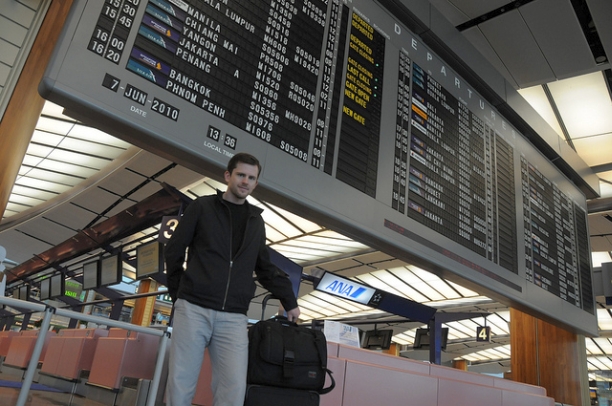
Still in his early thirties, Chris Guillebeau is one country away from completing a tour of every country on earth — all 193 of them — all while never having a “real job.” In his fight for eradicating conventional beliefs, he proves time and time again that “The Art of Non-Conformity” is not just a concept that works for him, but one that can work for anyone.
Ever since his first business, followed by four enriching years of volunteering for a medical charity in West Africa, Chris has never stopped traveling. He has given keynote speeches to presidents, spent time with indigenous populations and inspired people to become entrepreneurs. In doing so, he focused on three major topics: personal development and life planning, entrepreneurship and international travel.
For his latest book, The $100 Startup, Chris identified 1,500 individuals who have built businesses earning $50,000 or more from a modest investment (even from $100 or less). From that group, he’s chosen to focus on the 50 most inspiring case studies. In most cases, people with no special skills discovered that their passions could be monetized, and took the plunge in restructuring their lives towards greater freedom and professional fulfillment.
As he writes in his book, “You don’t need an MBA, a business plan or even employees. All you need is a product or service that springs from what you love to do anyway, people willing to pay, and a way to get paid.”
The Expeditioner: What was your first business idea and how did you come up with it?
Chris Guillebeau: Nearly 15 years ago, I learned how to buy and sell coffee. I loved the idea of earning my own income without depending on a traditional employer, so I kept trying different projects. Those that were successful, I put more effort into, and I haven’t had a job since.
How many days on average a year/month are you traveling?
About 150 days, I think. I’m usually away for two weeks at a time, then home for a while to work on books and other projects, then gone again.
You are one country away from completing your quest to see the entire world of 193 countries. How does that make you feel? What’s next?
It makes me feel both happy and sad. It’s been a 10-year journey, and in some ways I’m not ready for it to end. As for what’s next, well, I write, travel and connect with people. I don’t expect that will ever change . . . at least I hope it won’t.
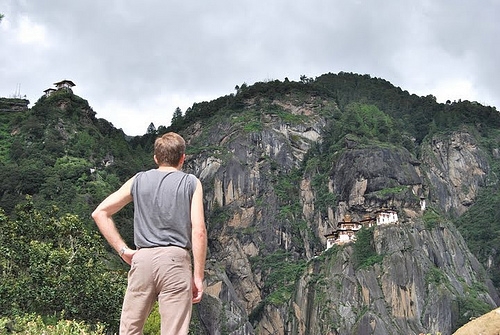
What are some of your favorite countries? Favorite continent?
South Africa, Macedonia, Liberia, Hong Kong, Laos . . . I could go on. I’m not sure I have a favorite continent, but I do love Australia — which of course is considered both a country and a continent in the U.S. system of geography.
You’re an expert in saving airfare costs, and so far you must have flown on thousands of flights. What’s your favorite airline and why?
A few favorites: Cathay Pacific, Singapore Airline, Royal Jordanian and Etihad. I’ll choose Cathay as number one since I’ve been with them dozens, if not hundreds, of times. I love passing through Hong Kong and the Cathay in-flight experience is great in all classes.
What was your worst flying experience?
More than once I’ve thought we’re going to crash, which is somewhat undesirable. Probably more common, though, isn’t the terrible flights but the sense of being stuck somewhere. I was stranded in Kiribati when the inbound flight had to return to Fiji for a mechanical issue. Waiting out the uncertainty of being stuck for an unknown amount of time was much worse than any bad flight.
What is your least favorite country (or countries), in which the local regulations greatly interfered with your travel plans?
There have been plenty of countries where I’ve run into trouble with regulations, but that doesn’t mean they are my least favorite. Sometimes, in fact, those countries are more interesting. I had trouble getting into Pakistan, for example, but once I made it I had a good experience.
What would be your first choice of living anywhere on the globe, if you had to move out of your home base of Portland, Oregon?
Sydney, Australia. It’s my favorite global city.
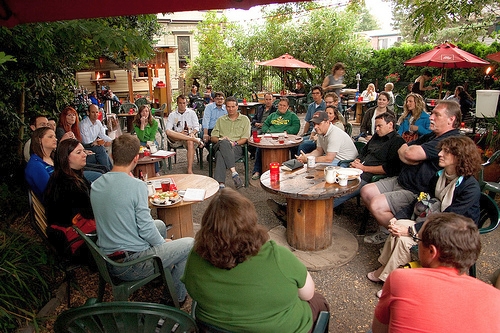
How was the process of choosing the 50 most significant case studies out of 1,500 entrepreneurs that contacted you for your latest book The $100 Startup? Could you name one that truly inspired you to make some changes to your own businesses?
It was a lot of work and a lot of fun. I was inspired many times over as I saw how so many ordinary people had been able to start businesses that earned at least USD$50,000 a year, and often much more. One of my favorite stories was Gary Leff, who started a six-figure (part-time!) business helping people book award tickets. He had constructed this business in a way that allowed him to continue working his day job, which he enjoyed. But he also had a fallback plan in case the day job stopped being meaningful.
Is one born an entrepreneur or does one discipline in becoming one?
I don’t think people are born with an inclination toward a certain career. At some point, one sees an opportunity and decides whether to pursue it or not. An entrepreneur will pursue it.
A start-up is a mountain to be climbed towards its peak. What would you say is the must-have “equipment” to reach the top?
Curiosity and the willingness to start something.
*
Quotes from The $100 Startup:
“The secret to a meaningful new career is directly related to making people feel good about themselves.”
“People will pay for information about travel, if packaged properly.”
“In the battle between planning and action, action wins.”
“Don’t think innovation, think usefulness.”
“Business opportunities are like buses; there’s always another one coming.” Richard Branson
“Good things happen to those who hustle.” Anais Nin
“Business is not a popularity contest.”
By Monica Suma

ABOUT THE AUTHOR
 Romanian by birth, but New Yorker at heart, there is nothing Monica enjoys more than traveling and exploring other cultures. Her 20-something relentless quests stem from a long bucket-list, always accompanied by her camera. Follow her adventures around the world on her blog www.Monica-Suma.com or on Twitter @MonicaSuma.
Romanian by birth, but New Yorker at heart, there is nothing Monica enjoys more than traveling and exploring other cultures. Her 20-something relentless quests stem from a long bucket-list, always accompanied by her camera. Follow her adventures around the world on her blog www.Monica-Suma.com or on Twitter @MonicaSuma.
The post One Country Away From Seeing Them All: Q&A With Roaming Entrepreneur Chris Guillebeau appeared first on The Expeditioner Travel Site.
]]>